Similar Posts
This past fall I had the opportunity to visit a construction project that is nothing short of a miracle. I saw a group of mostly volunteers and amateurs, working with small donations, building a church to rival any monument in the history of Christendom. The project was recently completed, consecrated by His Holiness, Patriarch Kirill, on December 27th, 2015. I would like to share what I have learned about this astonishing church.
In 2001, the Optina Monastery initiated a project to build a representation church in Moscow. Over time, however, the project outgrew this basic program. A hilltop site was located in Yasenevo, a district far to the south-west of the city center. It is the highest ground around Moscow, and many felt that the land had a providential destiny to hold a great church.
The immensely capable Archimandrite Melchisidek (Artyukhin) was appointed to direct the building project. It took seven years to acquire the land and the necessary permissions from the government to build there. In the meantime, it was decided to name the church for the Protection of the Mother of God, for the church, overlooking the whole capital city, would represent the Holy Virgin’s protection of Moscow. The project naturally took on the related theme of a war memorial, commemorating the military protection of the capital, and they made plans to ring the foundation with great stone crosses memorializing the many battles through history in which the city was threatened and preserved. The armed forces of Russia were moved by this gesture, and many contributions came from individual soldiers.
A third program emerged when Archimandrite Melchisidek noticed that the arches drawn by the architect in the crypt level closely resembled the Grotto of the Nativity in Bethlehem. He had the idea to recreate this holy site in the basement of his church, and in time this idea grew also. In the end, they built full-scale replicas of all the great pilgrimage sites of the Holy Land beneath the Yasenevo church – a miniature pilgrimage destination in itself, in the same tradition as the New Jerusalem Monastery built outside Moscow in the seventeenth century. These replicas are remarkable feats of sculpture, copying even the cracks and chips in the original stone slabs.
But most astonishing by far was the project to decorate the interior of the main church. It is ornamented in the style of the Sicilian Cathedrals of the 12th century – without doubt the most sumptuous and refined style that ever emerged in the Byzantine-influenced world. Virtually the entire inside of the Yasenevo church is mosaic iconography in glittering glass and gold. There have been but a handful of churches decorated like this in all of history, and this church ranks fifth among them in area of mosaics. The lower walls of the church are revetted in white marble and the floor is finished in splendid Cosmatesque marble and mosaic interlace. The church is lit with a great brass choros and a constellation of glittering chandeliers. The marble iconostasis bears jewel-like icons with a powerful Romanesque gravity. It is a vision of medieval splendor the likes of which have never before been seen in Russia, and only rarely in all the world.
The true miracle of the Yasenevo church, though, lies not in its richness, but its poverty. Astonishingly, this church, constructed in just seven years, had no major individual donors. There was no great oligarch or wealthy institution footing the bill. Rather, the money came in small donations from ordinary people and pious organizations – 800,000 donors in total.
Likewise, the astonishing mosaic work was not the work of a professional studio, but of students and amateurs, all volunteers. There was one professional iconographer hired to draw the great Pantocrator, but beyond that, the work was planned by highly-capable art students. They could not afford to buy Italian tesserae for the vast areas of gold, so they asked for donations of gold jewelry from across Russia, and developed their own technique for depositing the gold onto ceramic tile fragments. The mosaic workshop was run by a retired master who taught anyone who showed up. On the day I visited, she introduced me to her crew for the day – a hairdresser, an economics student, an architect, all there on their day off from work to come lay tesserae, and doing work like skilled masters. In total there were at least 225 of these volunteer mosaicists, some of whom arrived with no skills, but only a life-long dream of making an icon, and ended up creating works of incredible beauty.
My guide, Elena, explained that almost everything was built like this – the landscaping, the marble work, the unexpected and charming decorations that could be seen virtually everywhere. I found that the construction site felt like a liturgy – the workers could feel their priestly role in this work. Everyone involved in the project recognized that a miracle was taking place – that God had ordained that this project was to be different from any other – that this church would be built only with love, and that it would outshine all others.
Links:
A panoramic virtual tour of the church.
Photos of the consecration.
A video of Patriarch Kirill’s address during the consecration (in Russian).
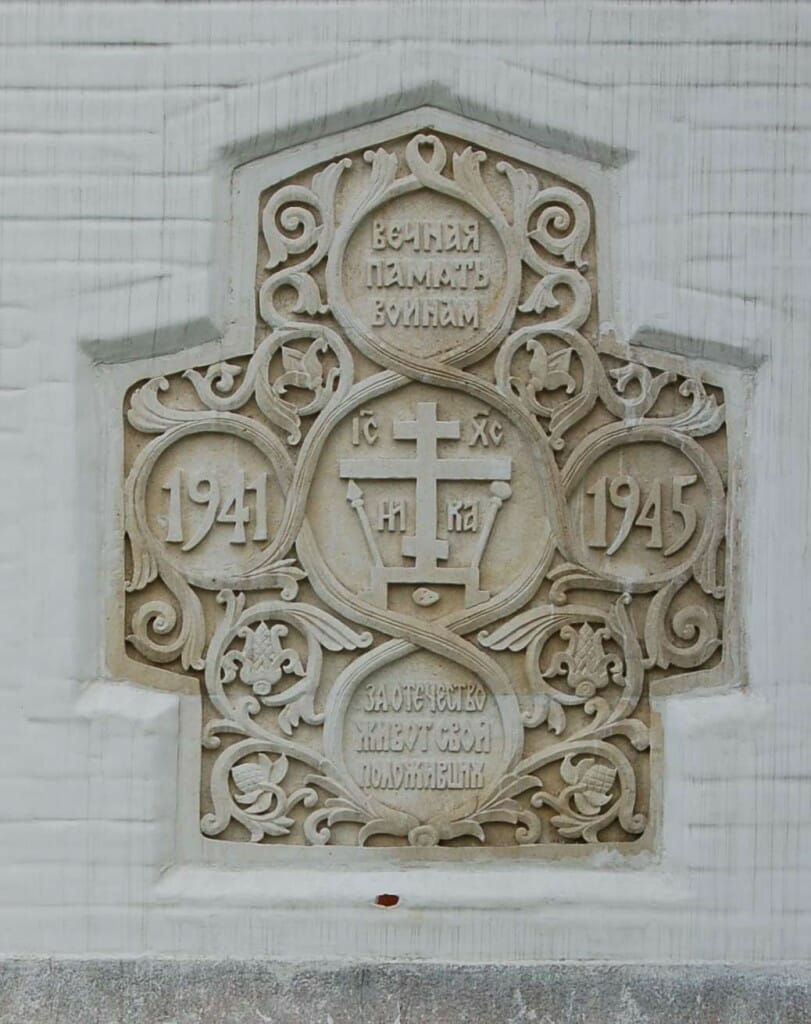
Cross commemorating the Great Patriotic War. The cycle of war memorial crosses around the foundation includes one more cross after this one, which is currently blank. May God grant that it remain so.

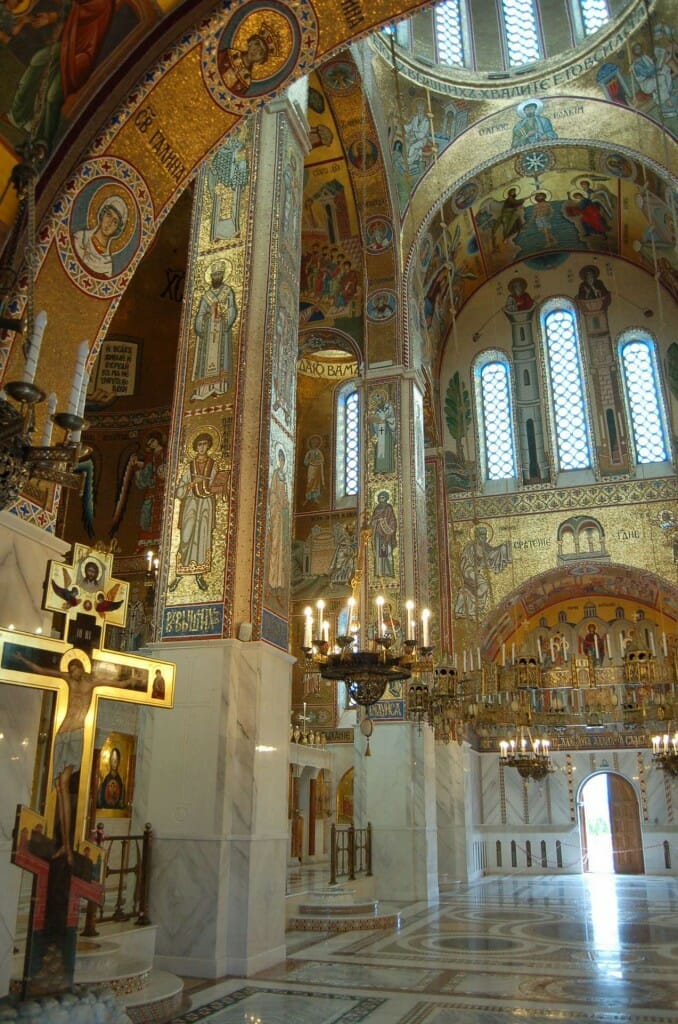
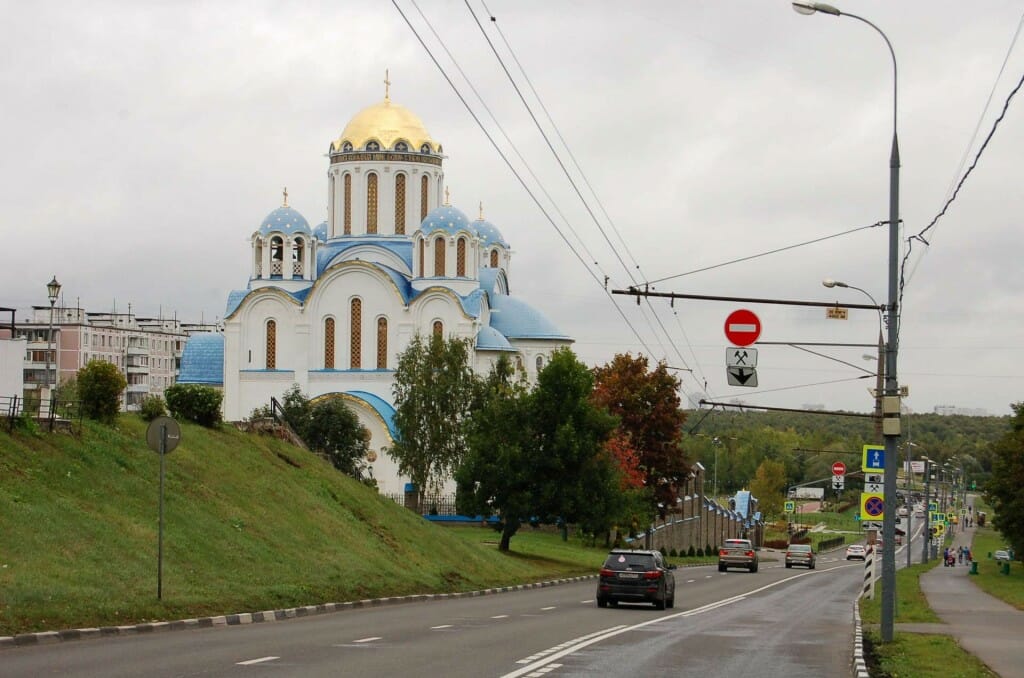
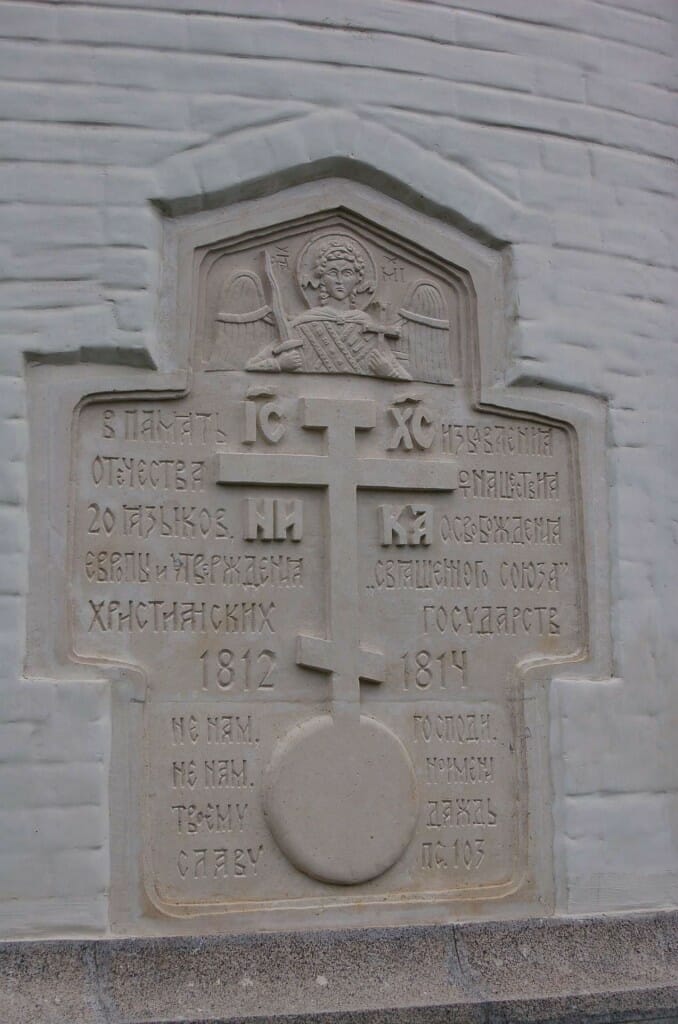
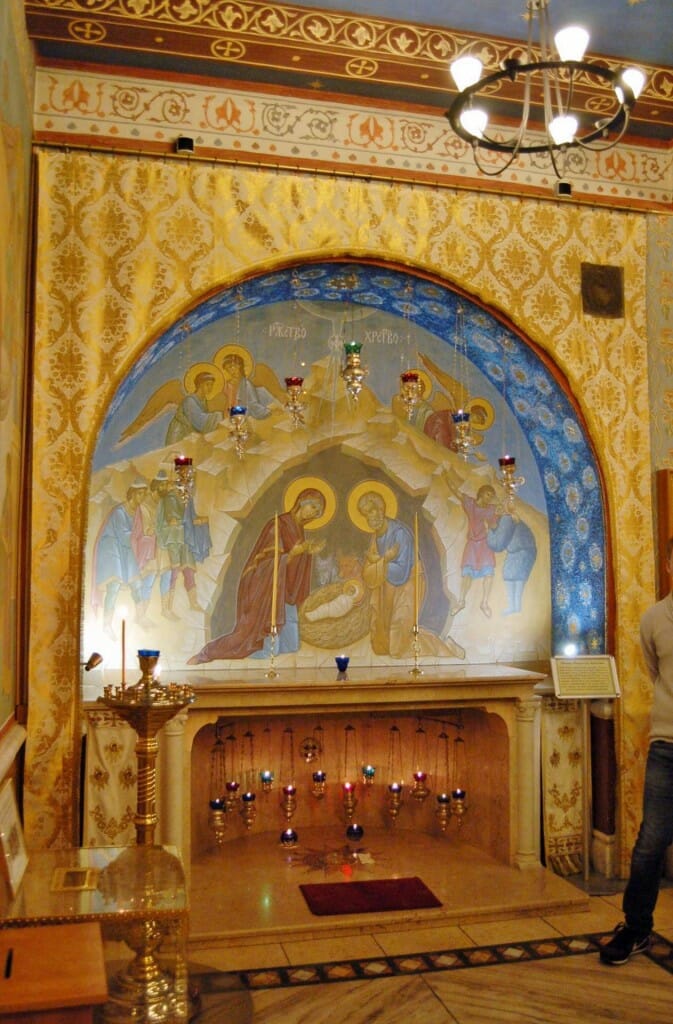
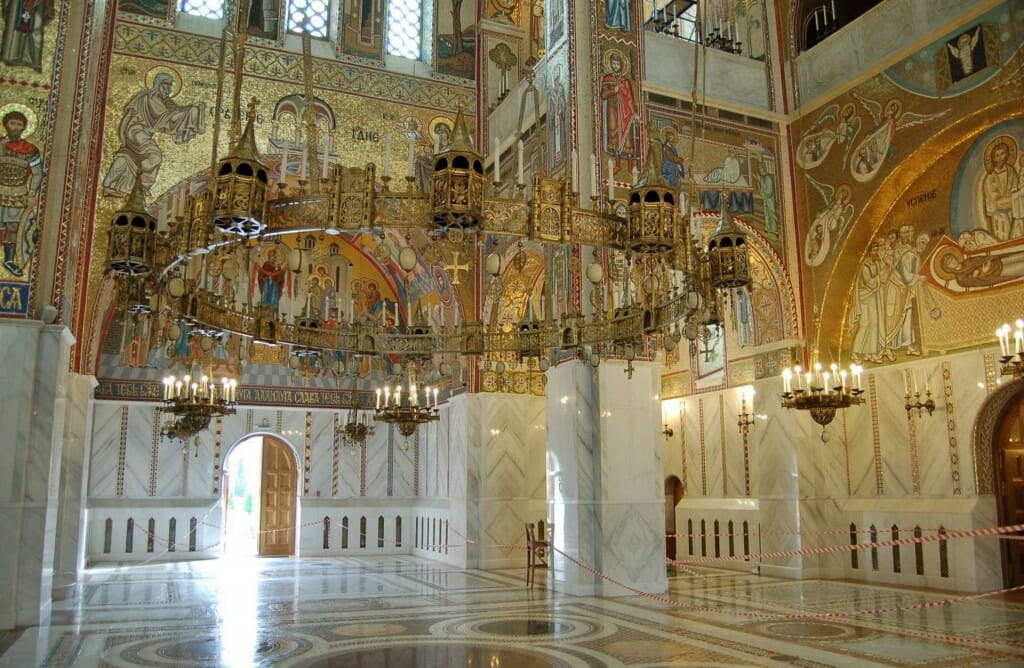
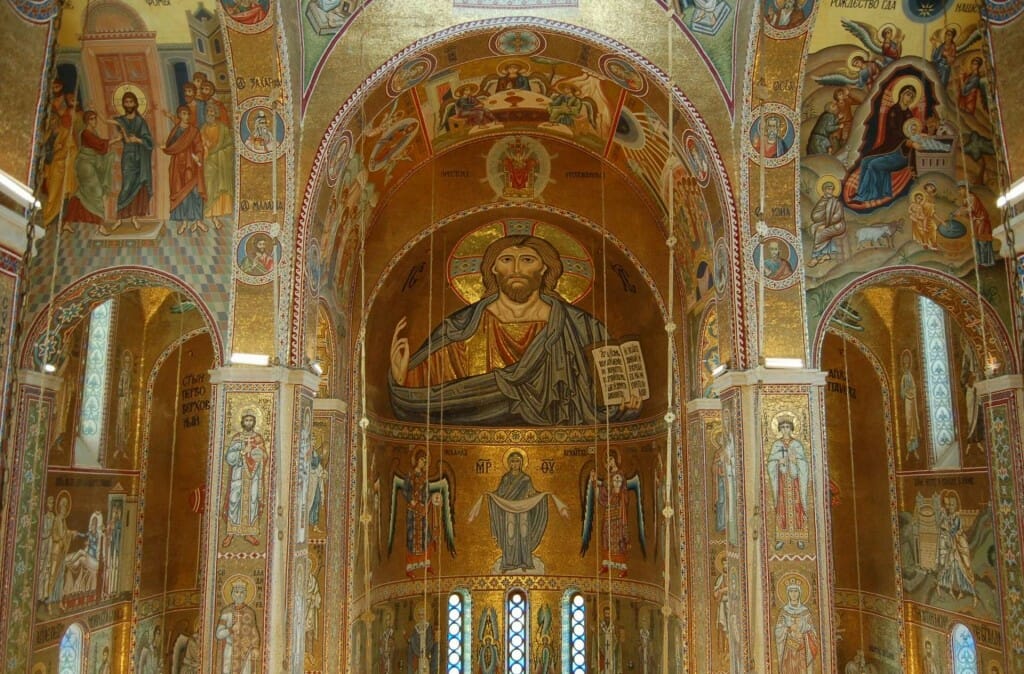
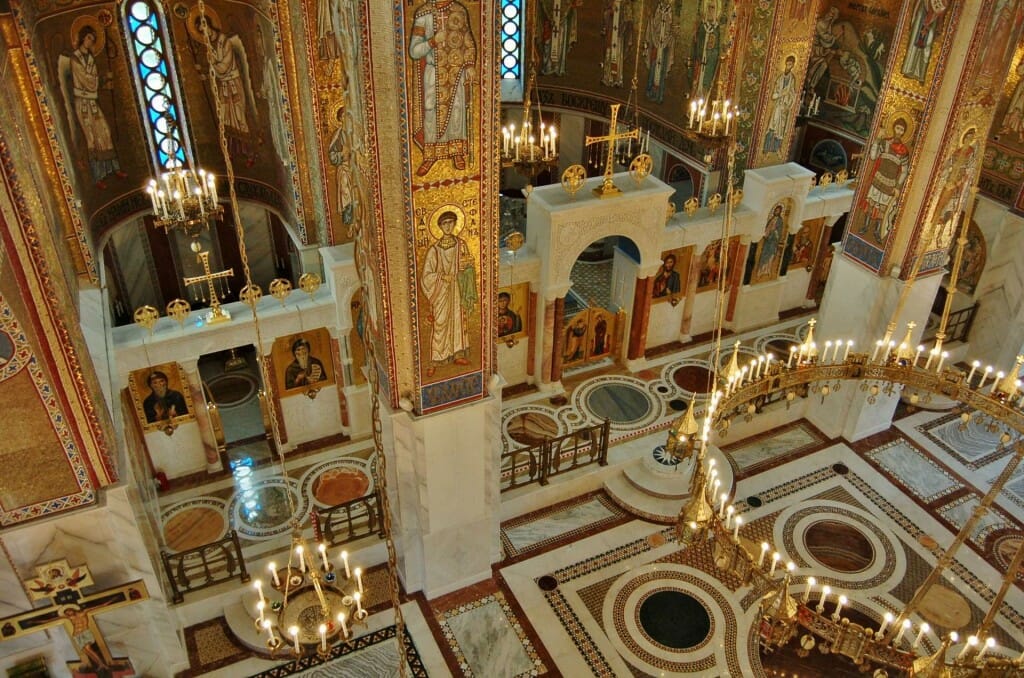
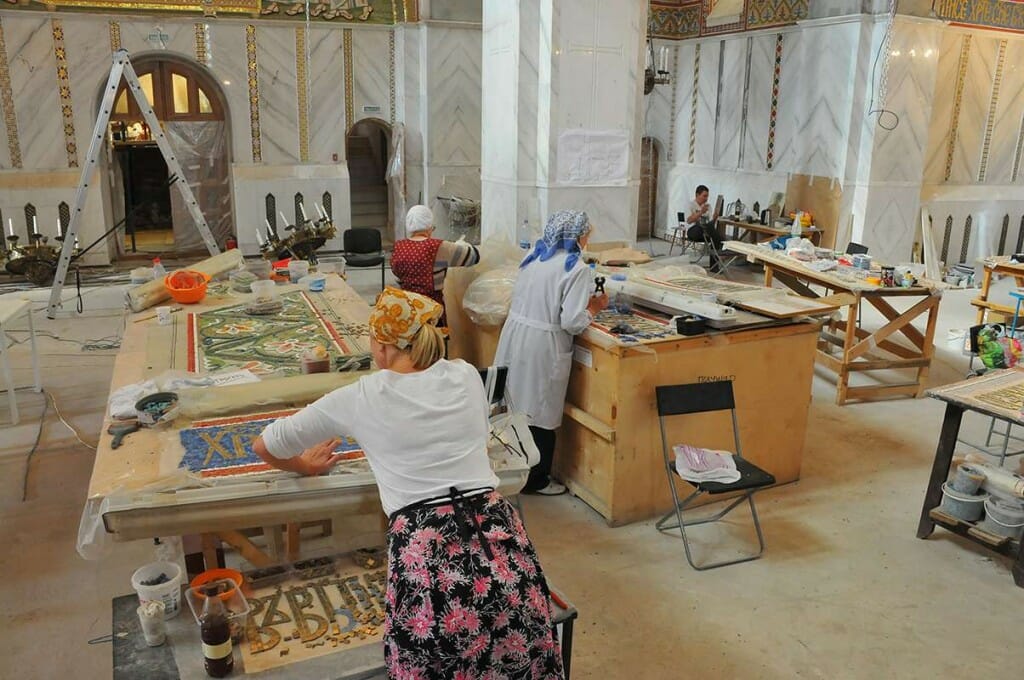
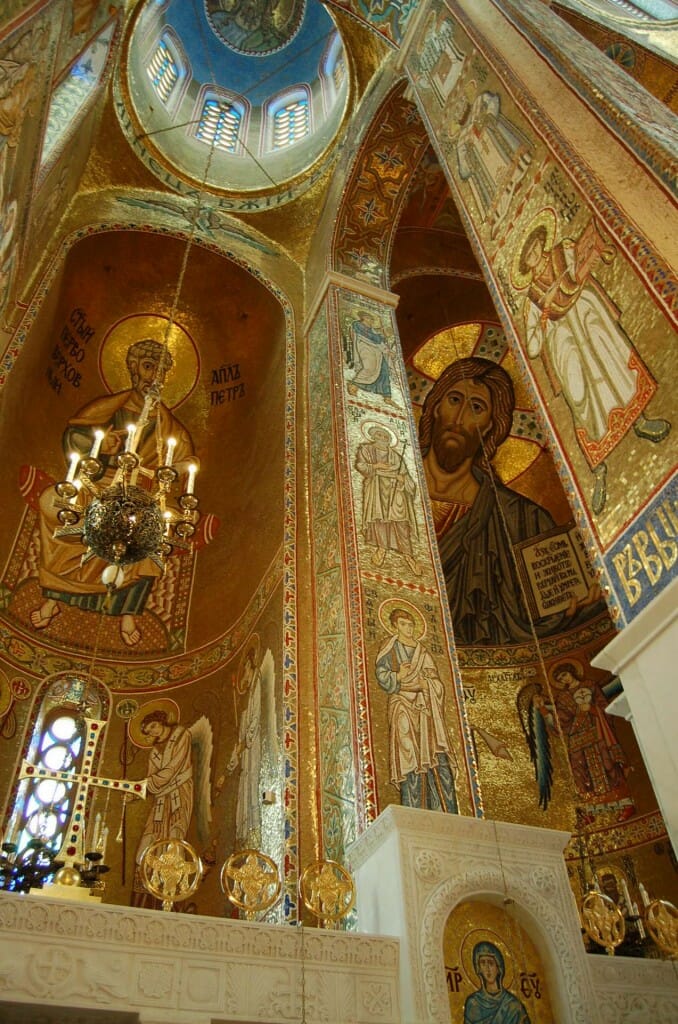
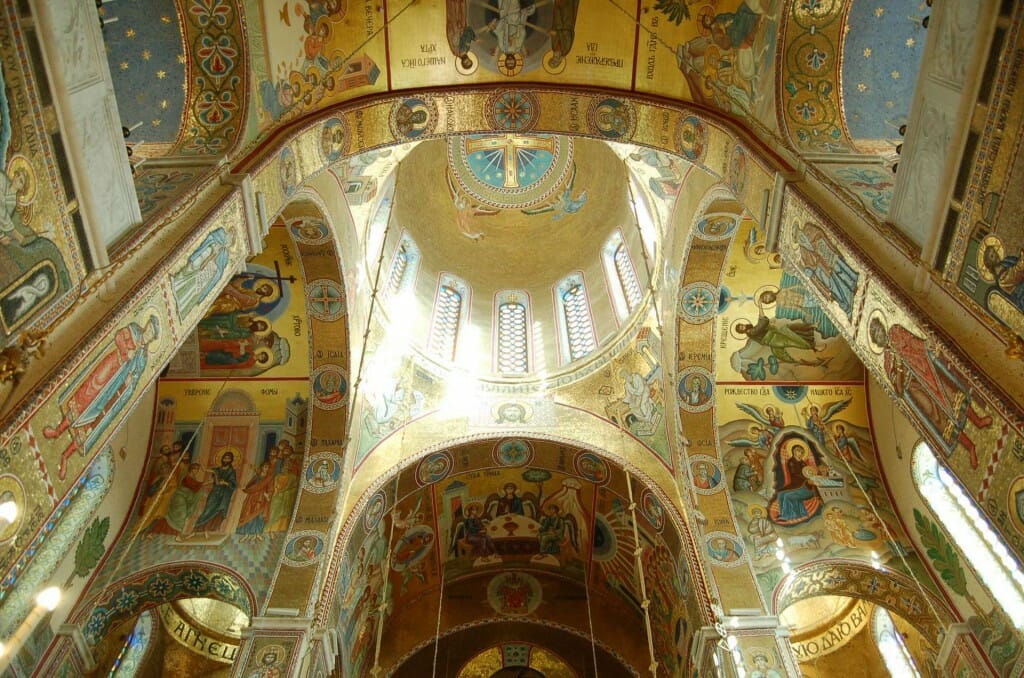
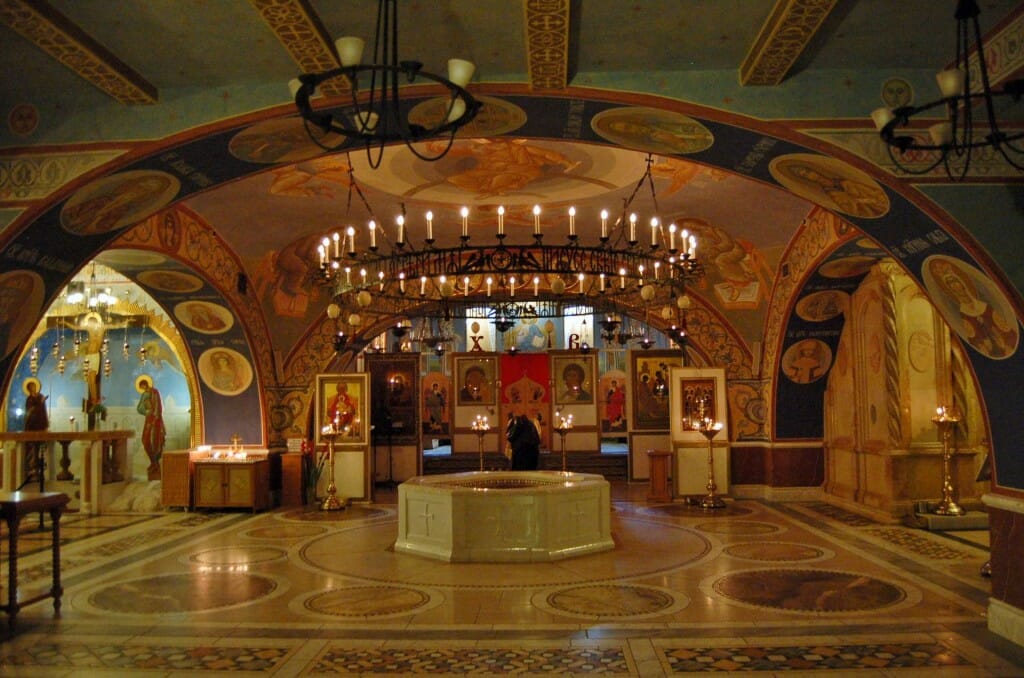
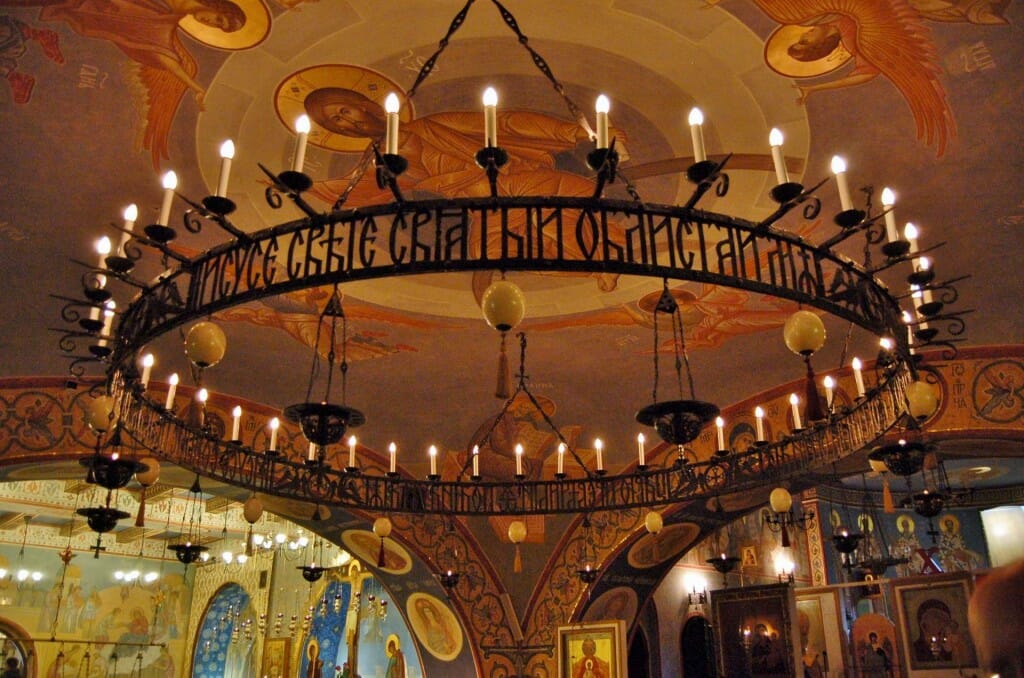
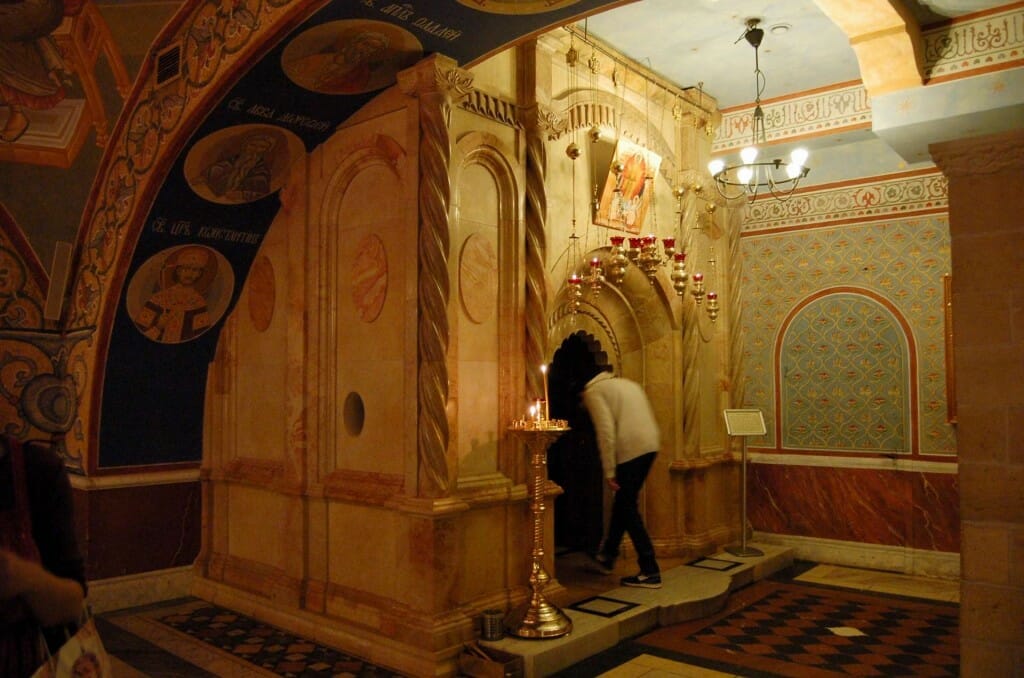
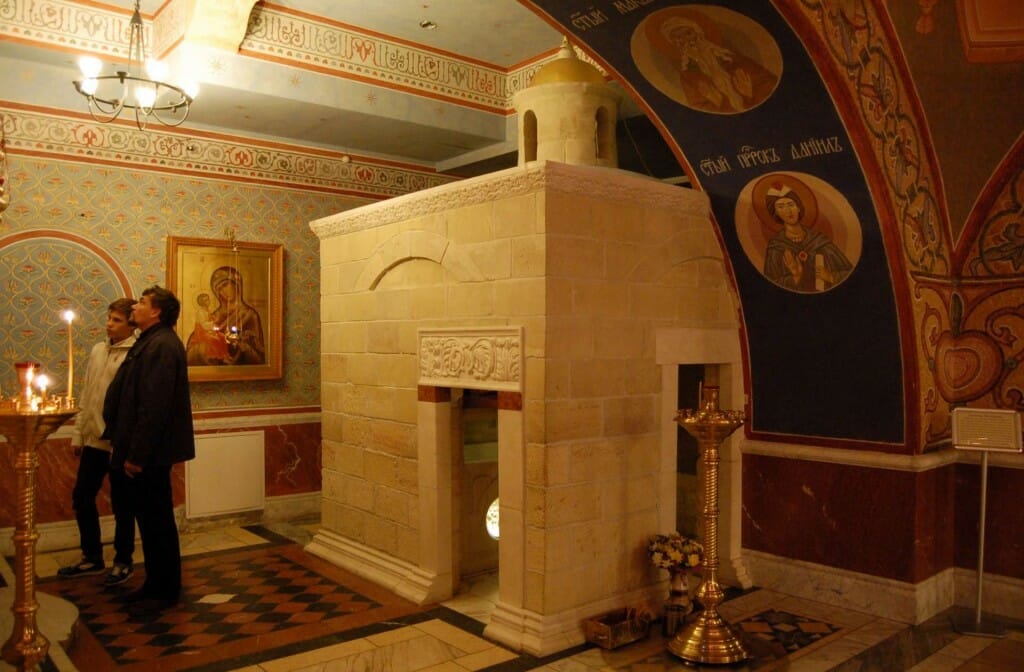
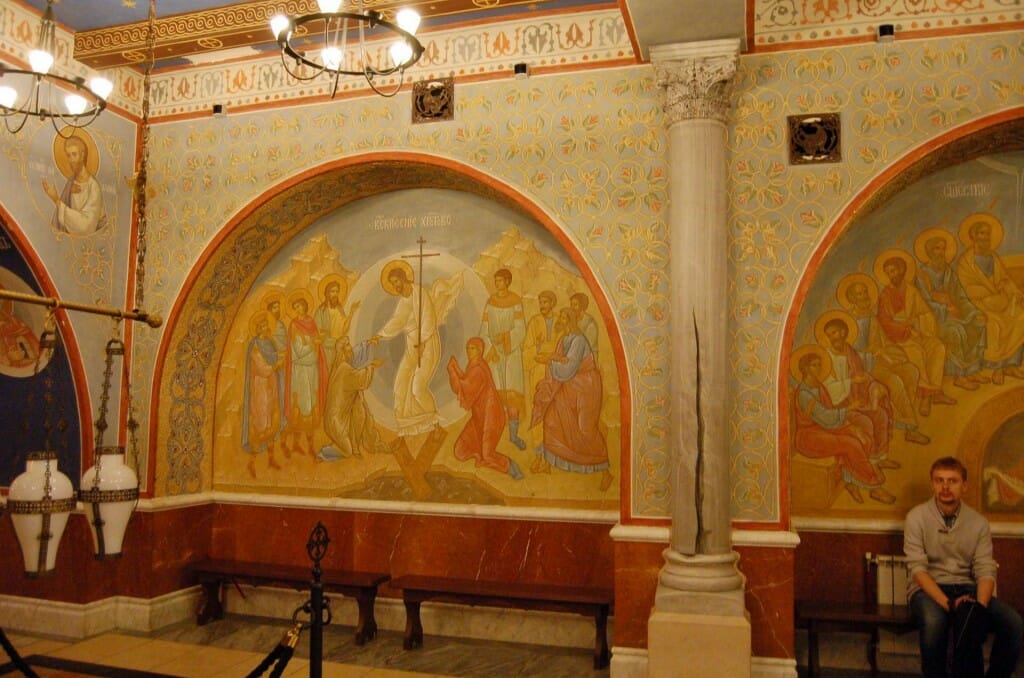
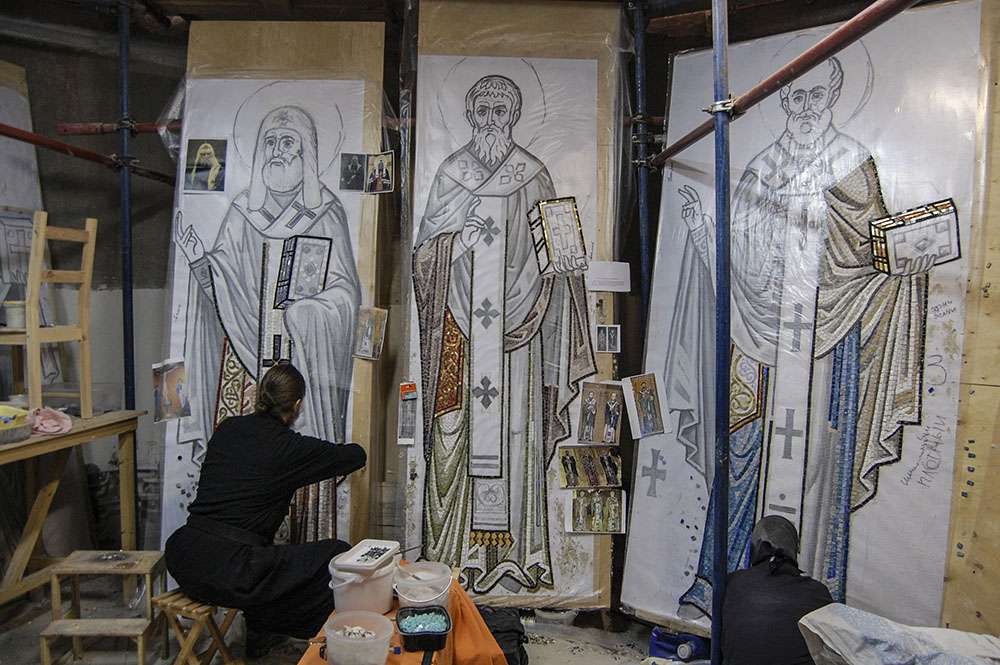
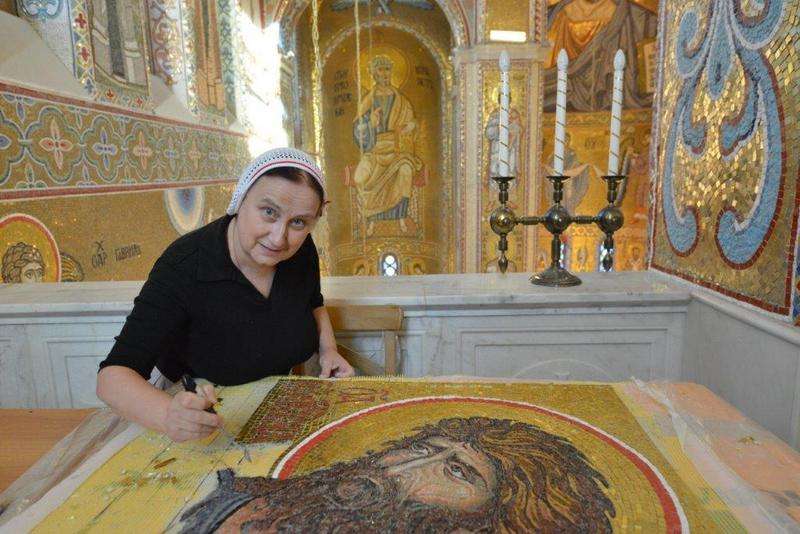
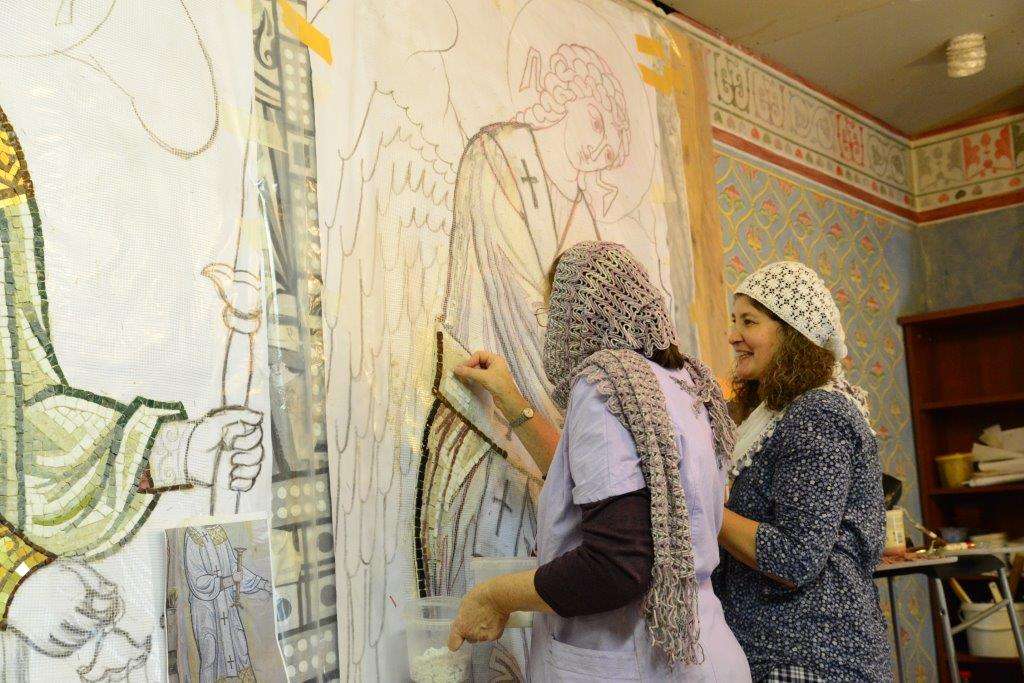
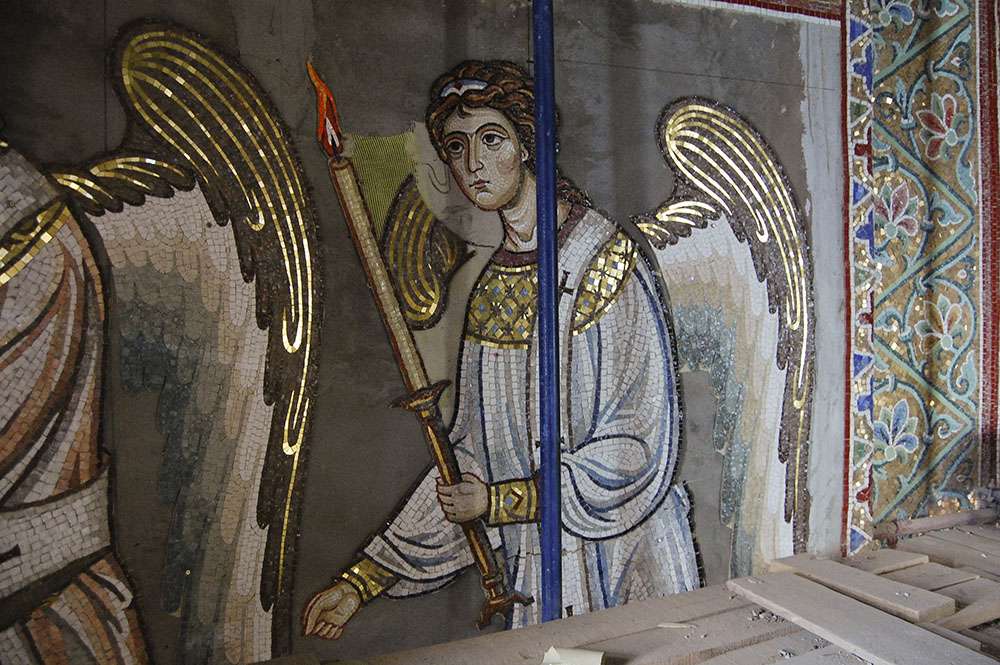
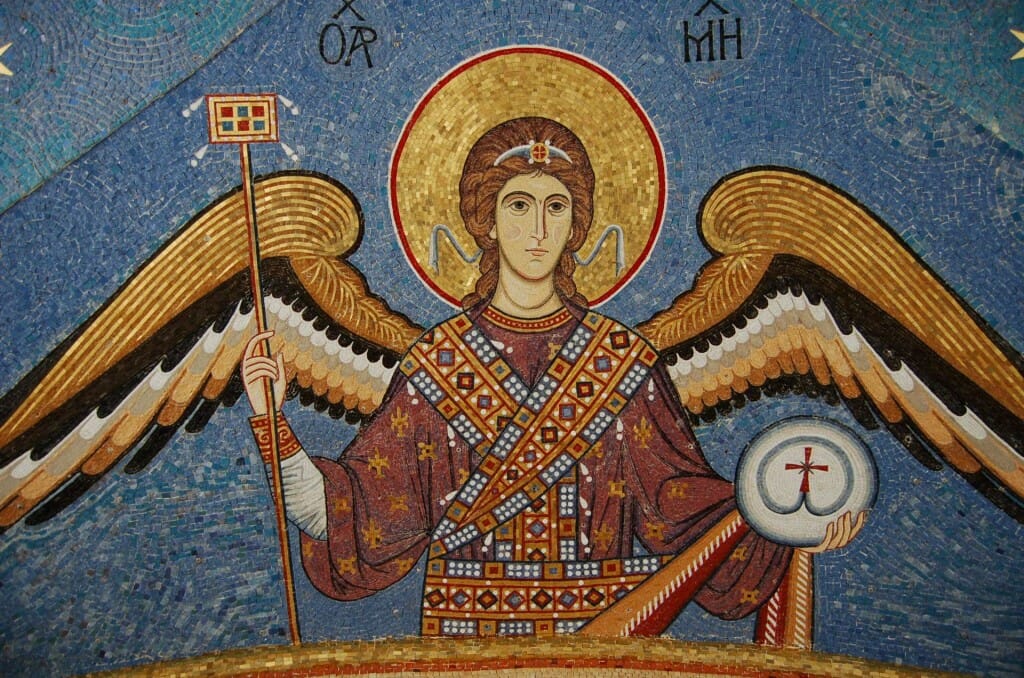
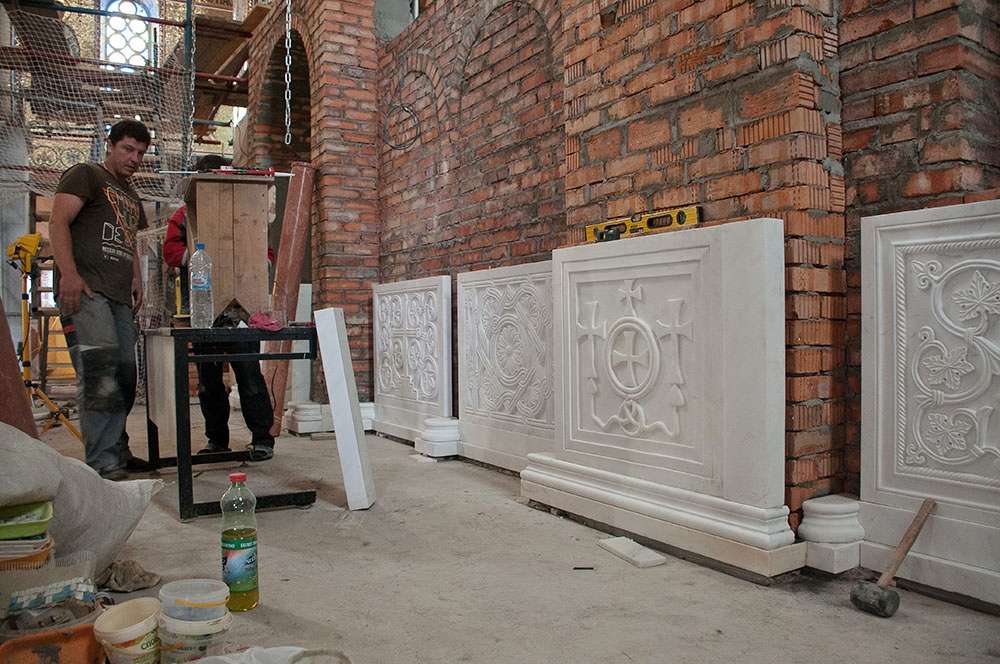
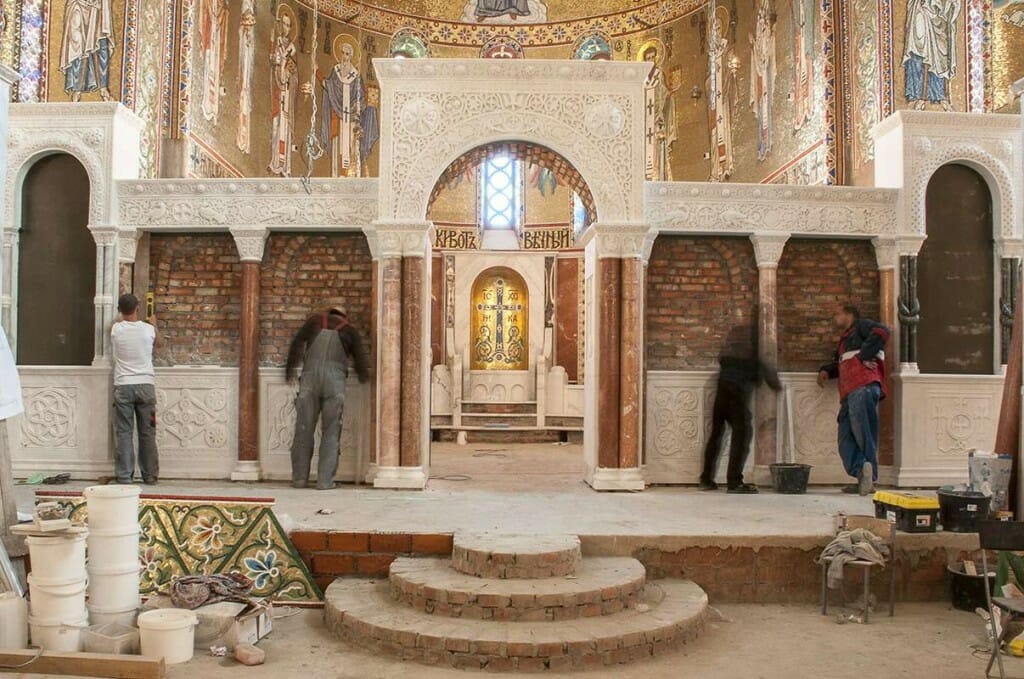
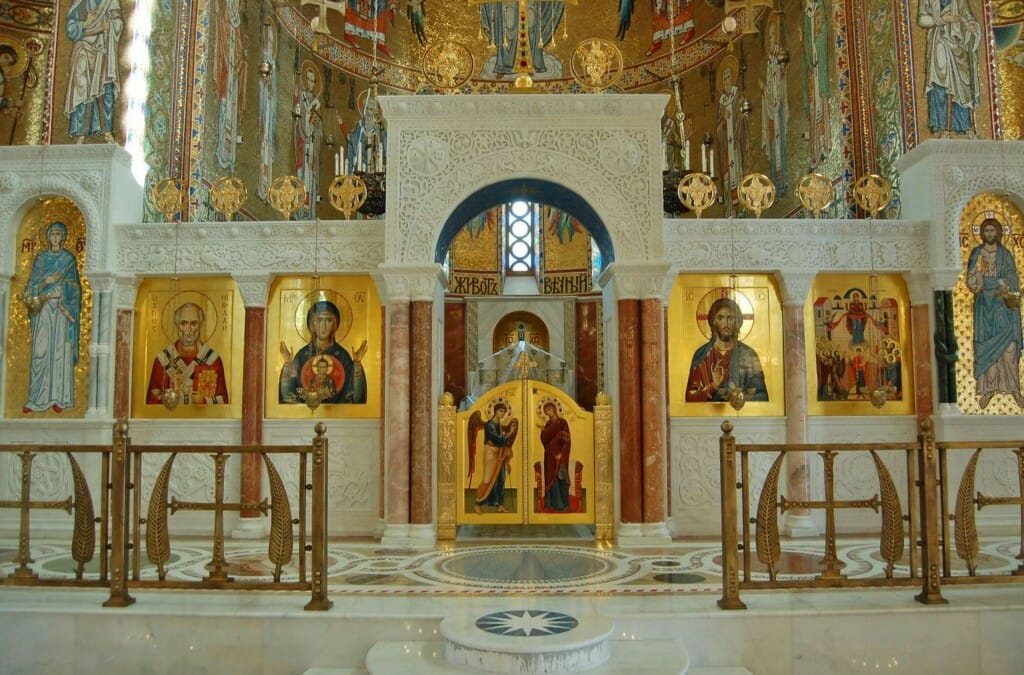
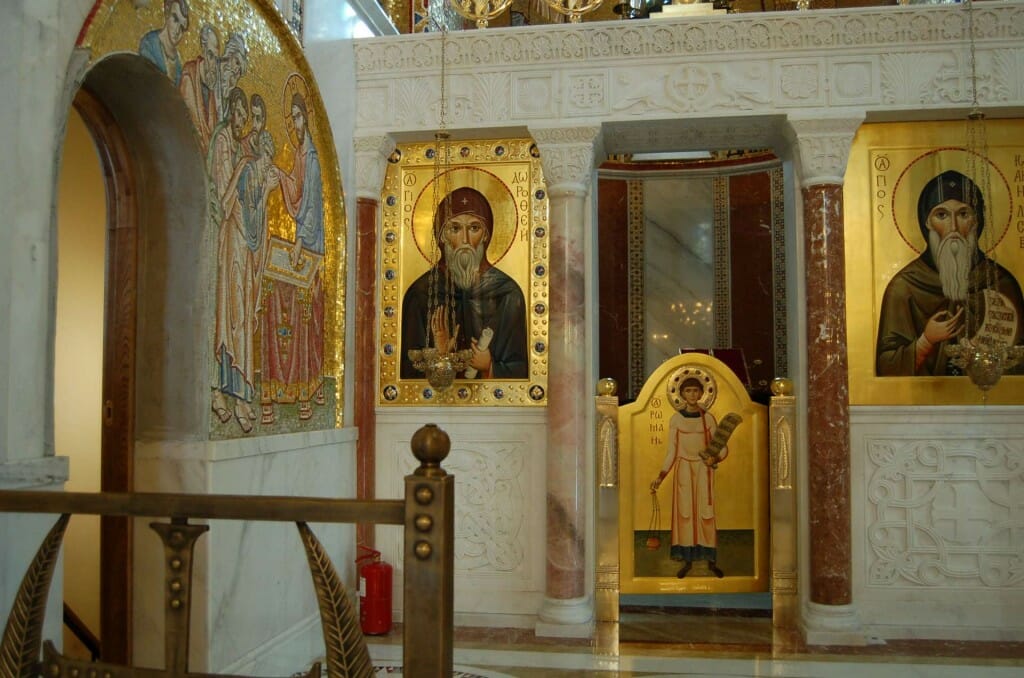
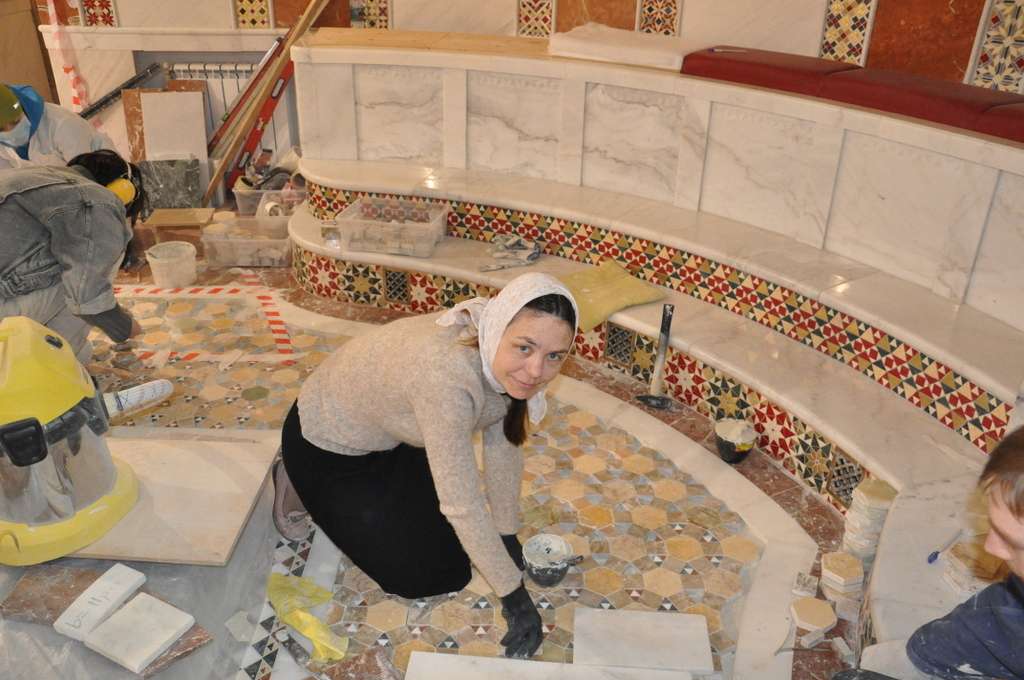
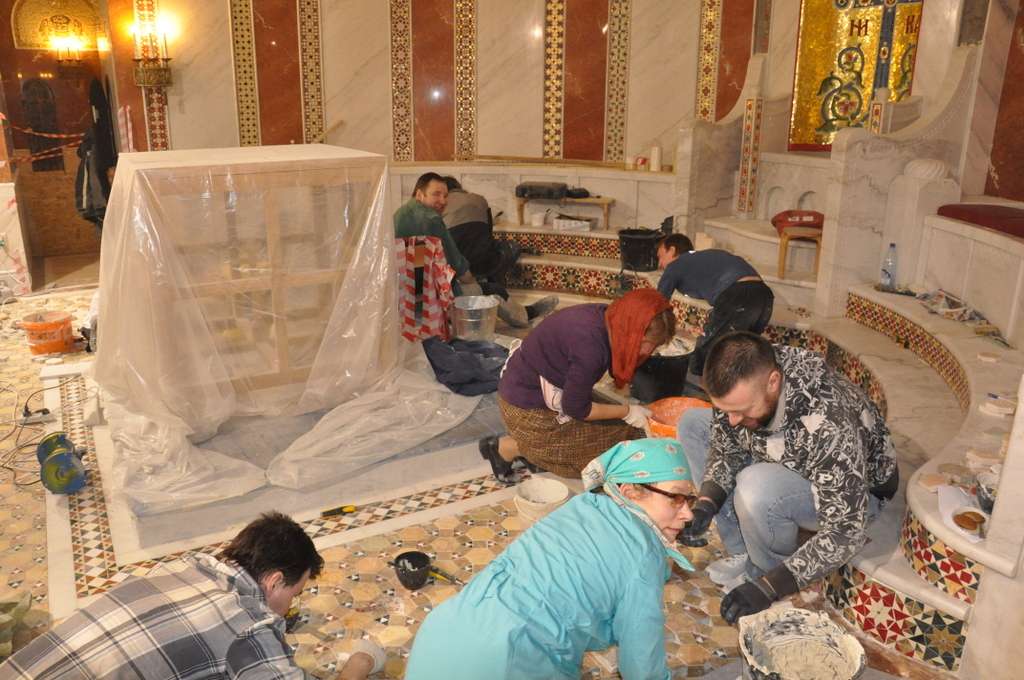
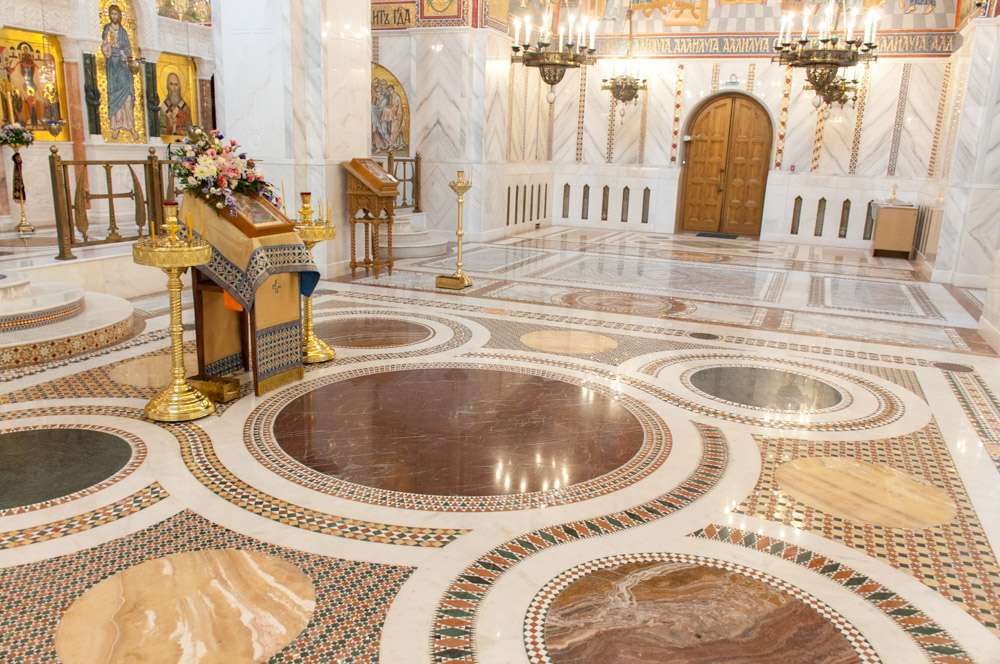
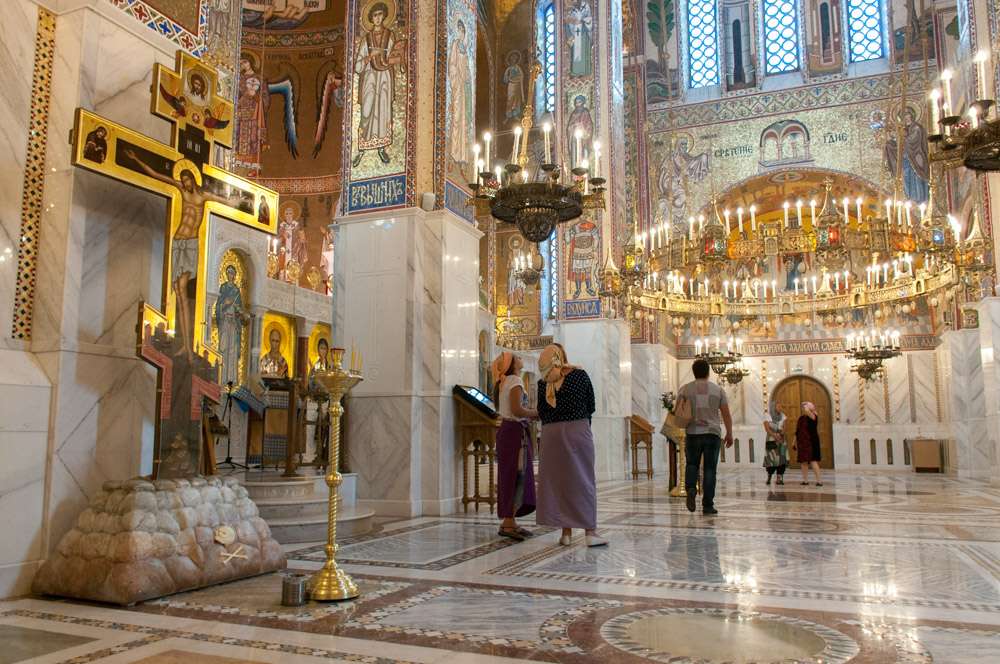
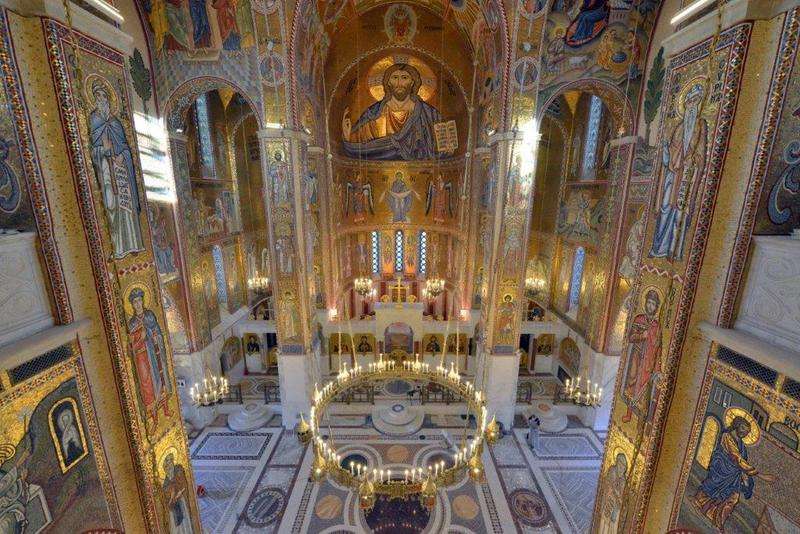
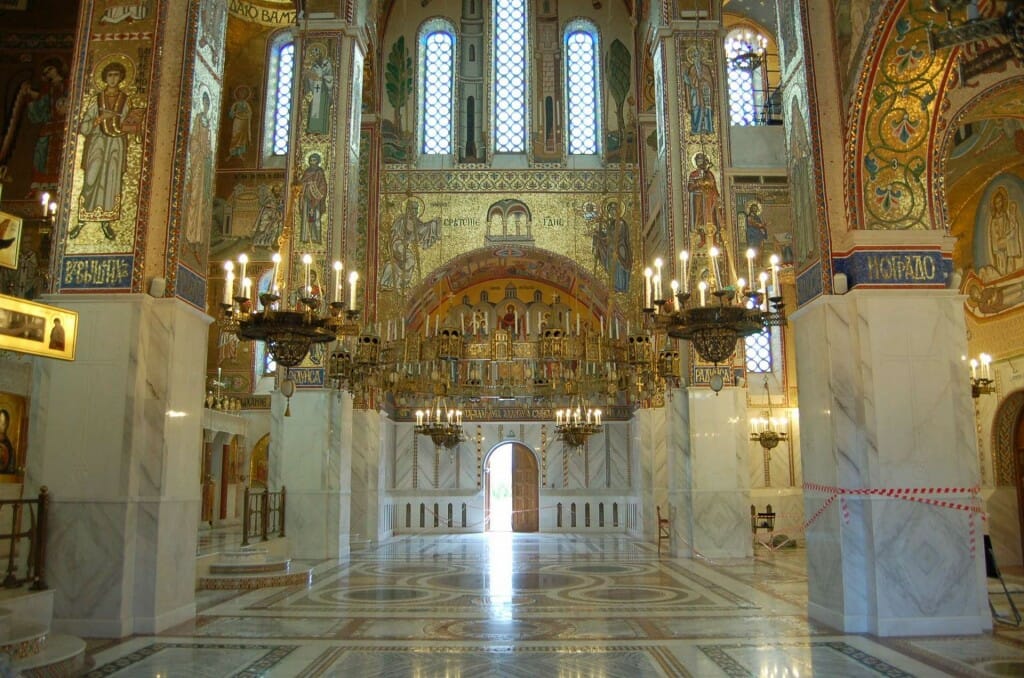
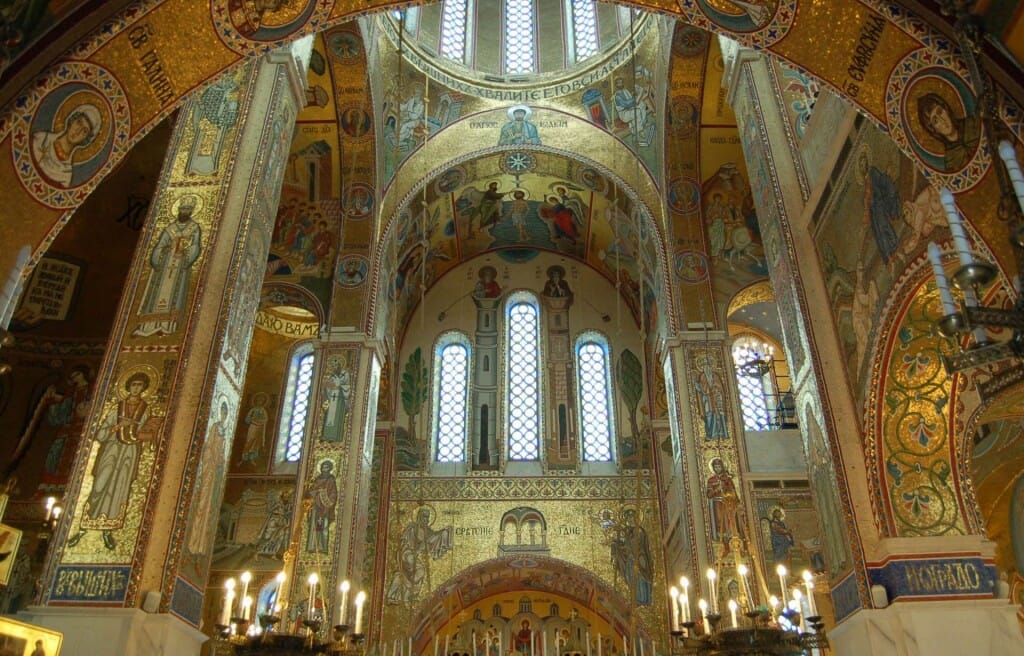
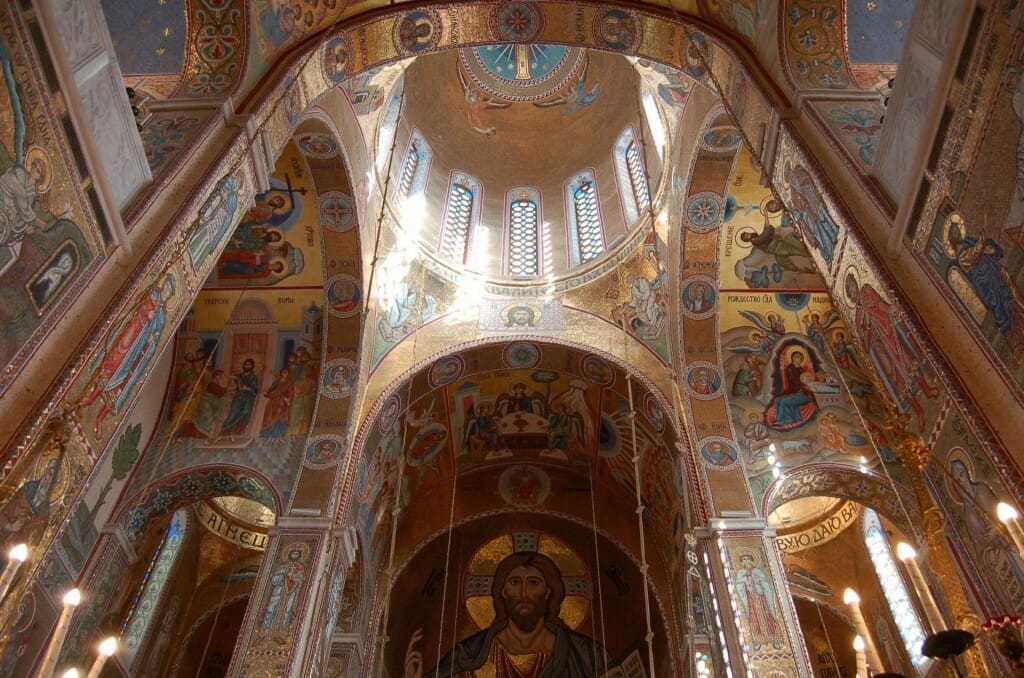
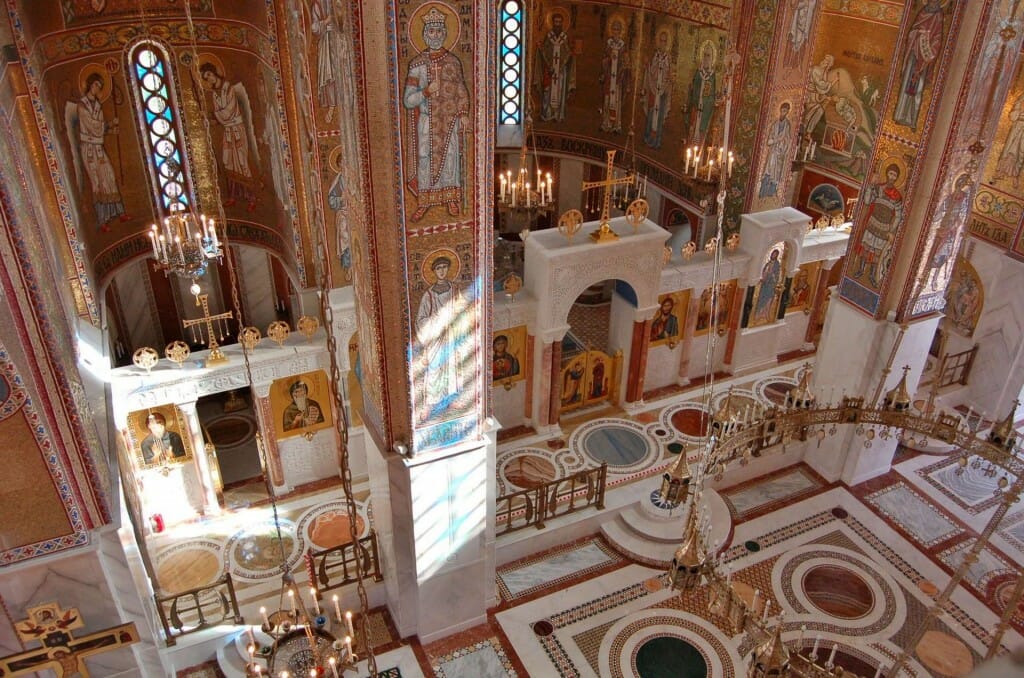
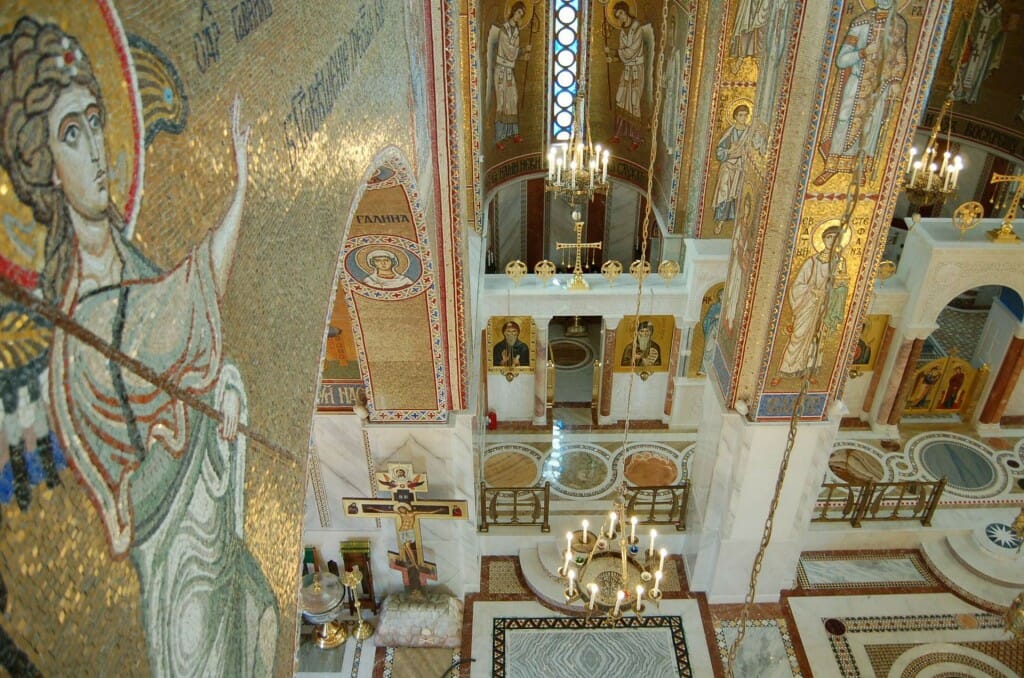
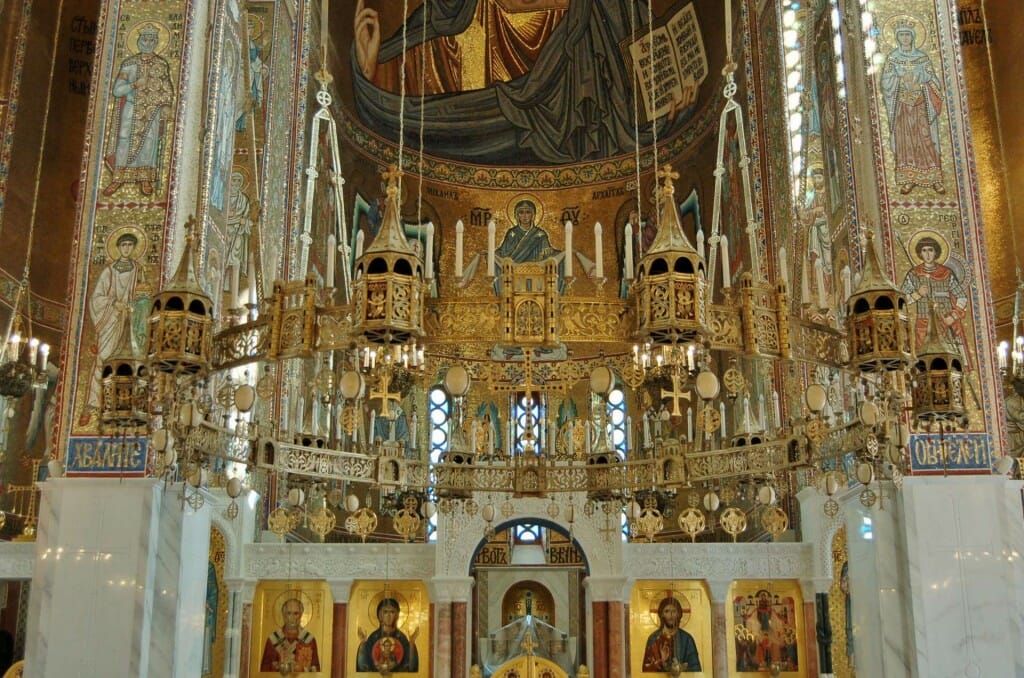
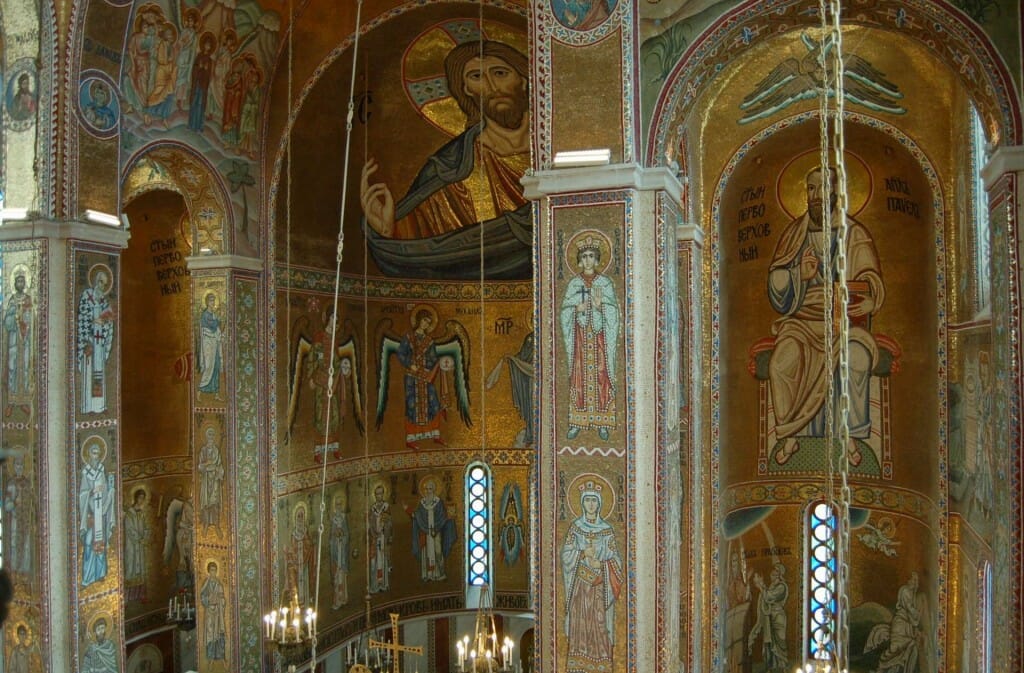
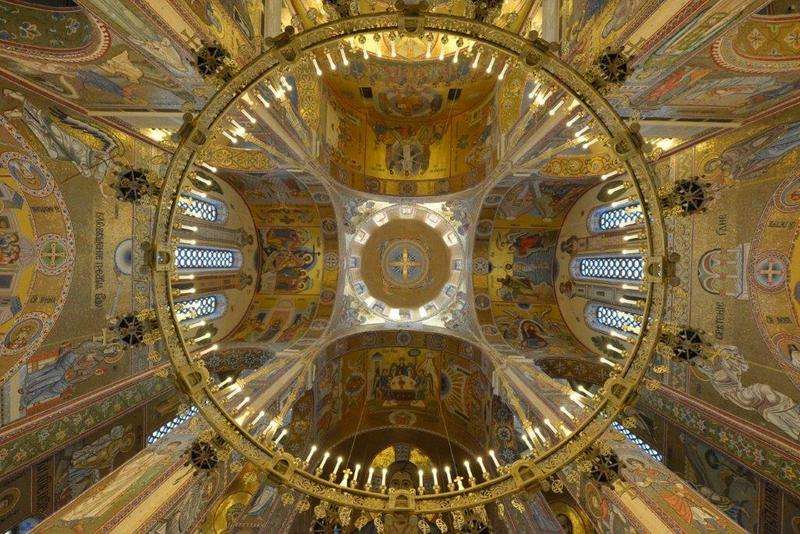
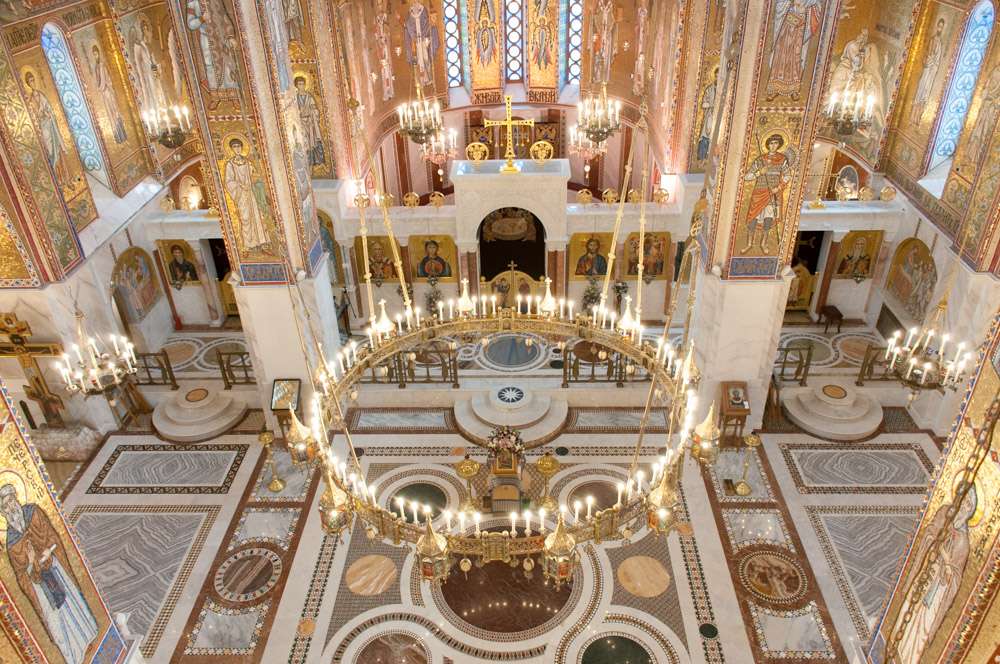
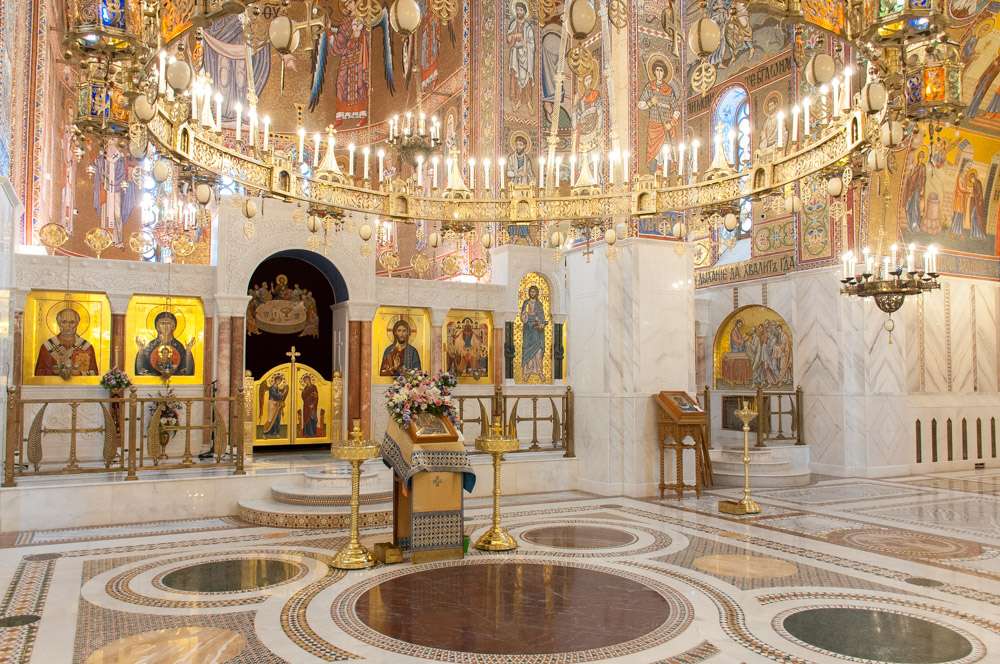
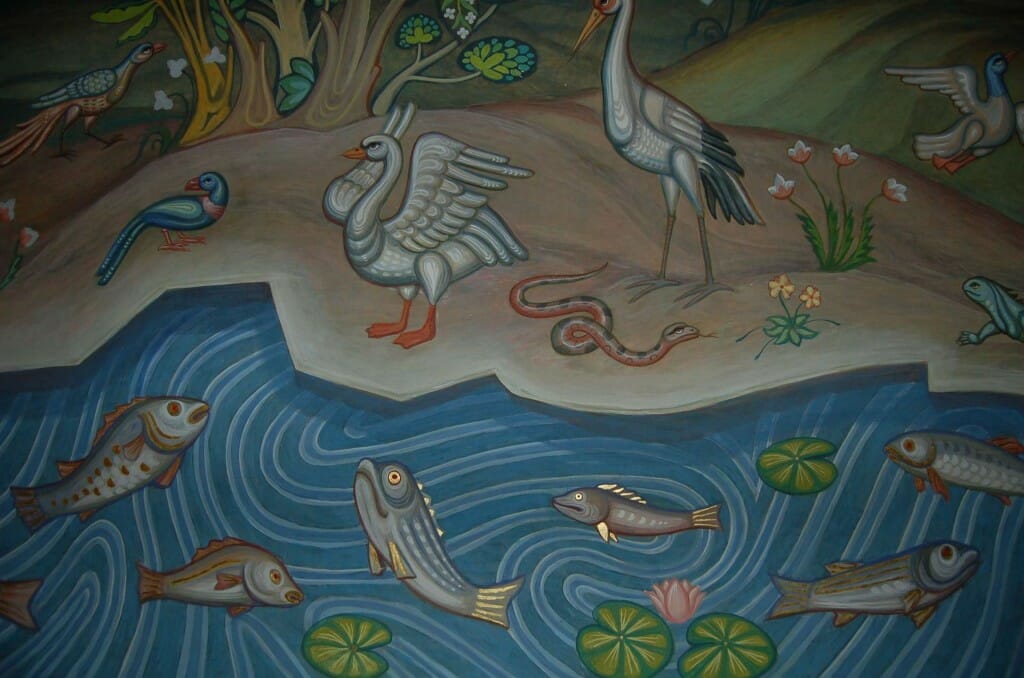
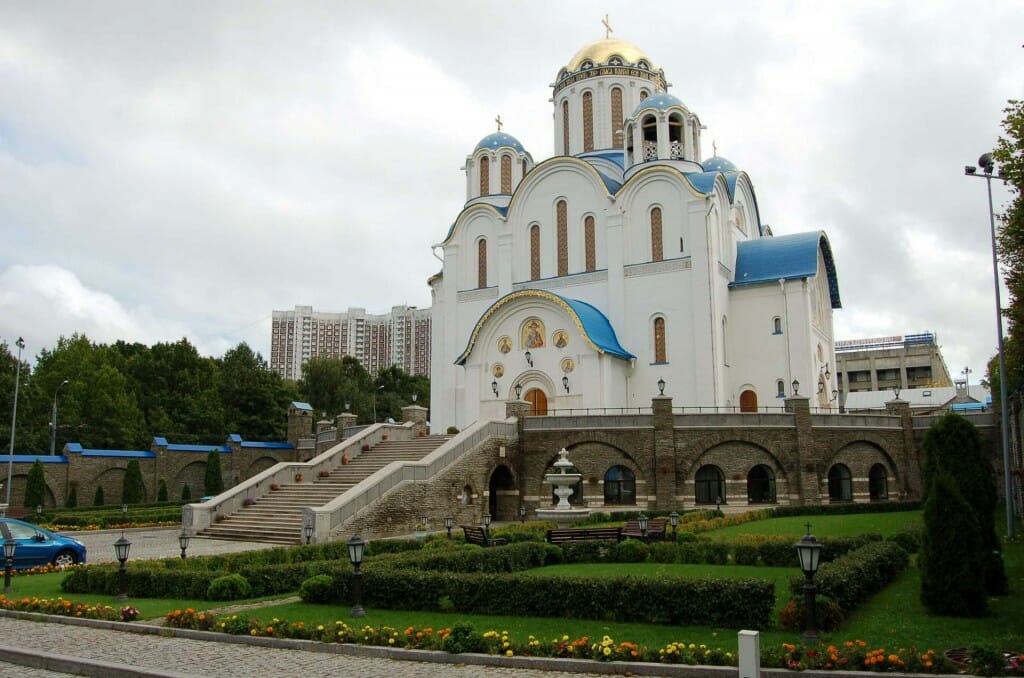
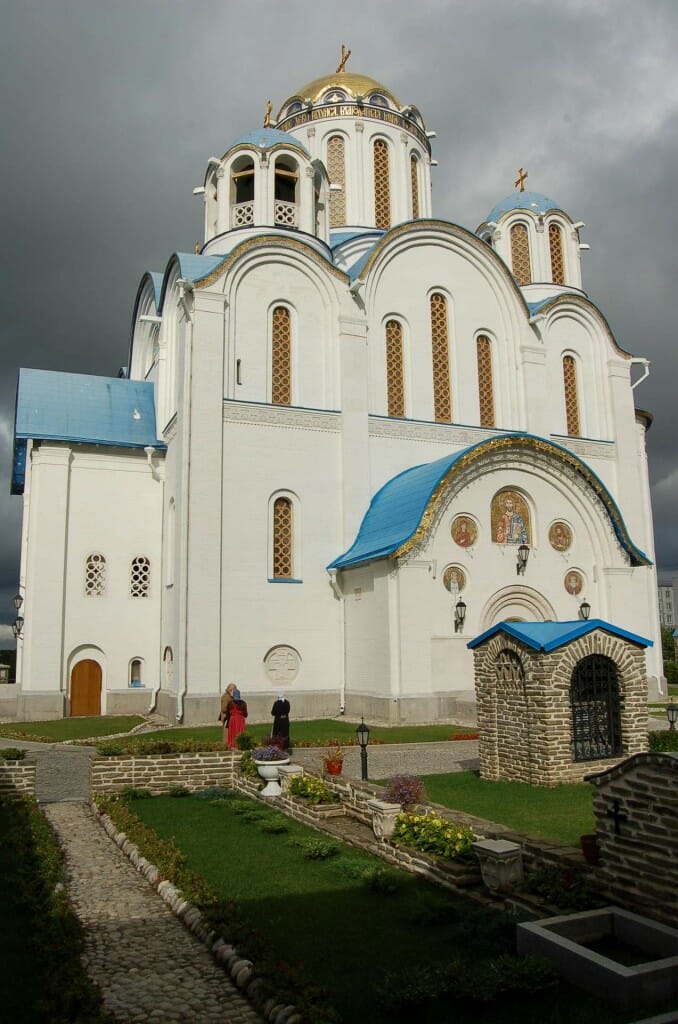
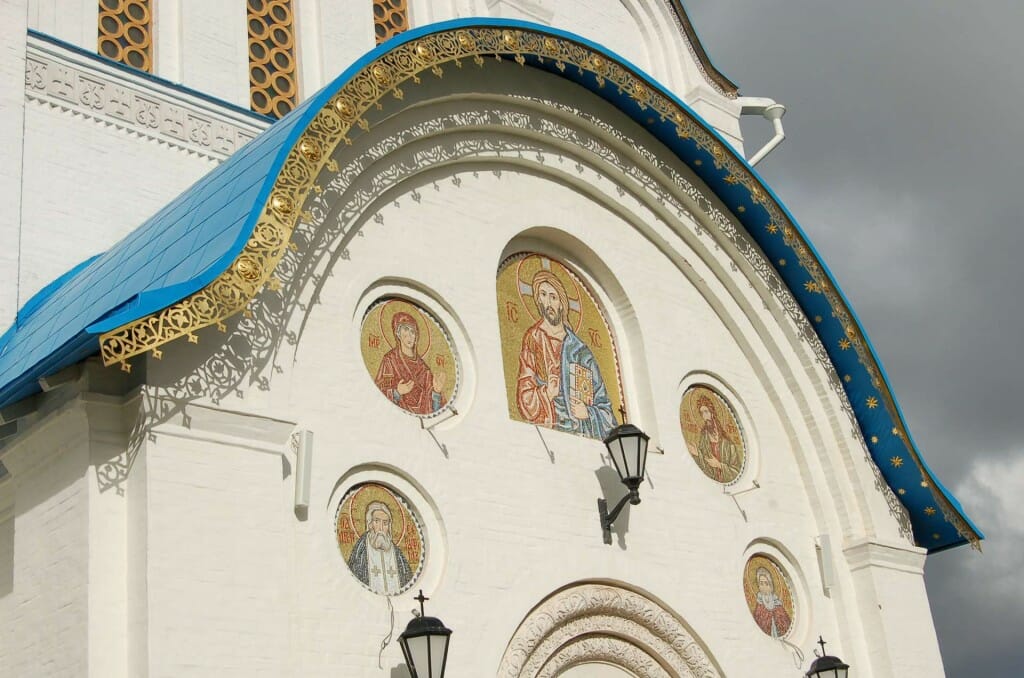
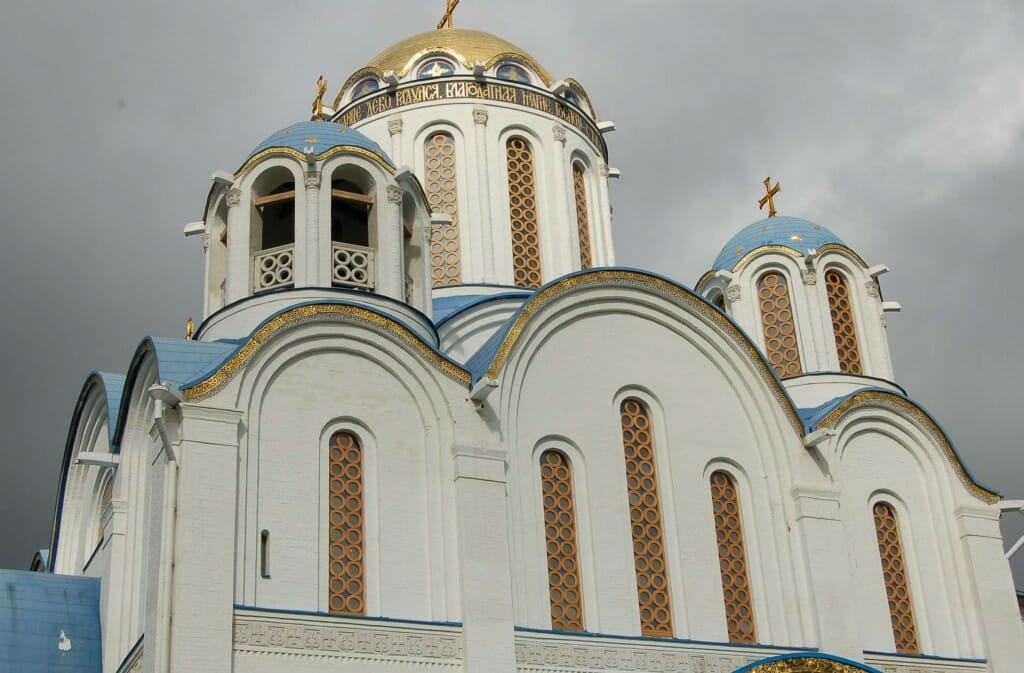
Une pure merveille à la Gloire de Dieu. Louange soit rendue au Seigneur pour tous ces bénévoles et donateurs qui ont participé.
J’aimerais participer par ma pauvre prière. Merci Seigneur d’avoir donné ce courage à toutes ces personnes. Merci de redonner vie à notre Église.
Micheline du Canada
Un autre Canadien qui replique; beaute, fois, effort; incroyable. Archimandrite Luc
Je suis au Québec et je suis d’accord avec toi. Cette église est merveilleuse et les circonstances entourant sa construction aussi. Que Dieu préserve ces fidèles orthodoxes nos frères en Russie dans les siècles des siècles. Amin !
Patrick (nom orthodoxe), Trois-Rivières, QC
This has left me breathless! Not only the beauty of it, but those who contributed money or labor.
By the work of their hands, God is truly praised.
Andrew, Thank you so much for this beautiful story and photos. Both so beautiful they brought tears to my eyes. The love expressed by the citizens of Russia is overwhelming. I wish all the world could see this. Praise be to Jesus Christ and His Holy Mother!
Cathy McDonald (USA)
Appare come un’ opera meravigliosa di altri tempi ,i tempi della fede che viene trasmessa di generazione in generazione e non la ricerca di originalità a tutti i costi .
This is breathtakingly beautiful. The Spirit is so present in this work. The Art is exquisite.
Superb, beautiful, wonderful. I didn’t know whether I was in heaven or on earth. Inspirational. Congratulations to all concerned.
Beyond words. The history is just as beautiful as the workmanship. Thank you for sharing this wonderful story, and pictures. Does anyone know why the Pantocrator is not centered in the dome? Just curious. God Bless and I pray for the great success of this beautiful church and its community. In Christ, Cherie
The placement of the Pantocrator in the apse is in accordance with the Norman-Sicilian churches that are the model for this interior scheme. In general, ancient Western churches had the Pantocrator in the apse, whether or not the building had a dome. Notice that in this church they have placed the uniquely Eastern image of the Theotokos holding her protecting veil directly below the Pantocrator. It may be that the iconographers felt that the combination of these two images – the Theotokos with the veil, and the Pantocrator, was sufficiently equivalent to the usual Eastern apse composition of the Virgin of the Sign, since it includes both Christ and Mary.
I also notice that in these very tall and narrow Russian churches, a Pantocrator in the dome has very little liturgical impact, because you have to look straight up to see it. Thus in Russian cathedrals, the iconostasis, and particularly the deesis tier, is much more the focal point. But this church has a very low and simple iconostasis, so the architect must have wanted the apse to be the focus instead, so it makes sense to have the Pantocrator there.
The 14th century Glabas chapel at the Pammakaristos in Constantinople has an enthroned Pantokrator with his arm extended in blessing in the apse. I think it was more common than we realize in Byzantine times. The Cefalu and Monreale apses must have been based on some lost Byzantine monument from the Comnenian period. They were certainly in the latest fashion, so to speak.
“Then everyone came whose heart was stirred, and everyone whose spirit was willing, and they brought the Lord’s offering for the work of the tabernacle of meeting, … They came, both men and women, as many as had a willing heart, and brought earrings and nose rings, rings and necklaces, all jewelry of gold, that is, every man who made an offering of gold to the Lord. … All the women who were gifted artisans spun yarn with their hands, and brought what they had spun, of blue, purple, and scarlet, and fine linen. And all the women whose hearts stirred with wisdom spun yarn of goats’ hair. The rulers brought onyx stones, and the stones to be set in the ephod and in the breastplate, … See, the Lord has called by name Bezalel … and He has filled him with the Spirit of God, in wisdom and understanding, in knowledge and all manner of workmanship … And He has put in his heart the ability to teach…” from Exodus 35: 20-34
Absolutely magnificent in every way.
Upon viewing the awesome beauty of this church and reading how it was built is truly miraculous and it left speechless but full of joy and praise to Almighty God! Its splendor points to the splendor and awesome majesty of our God the blessed Trinity. Glory to God! Such beauty is one of the reasons I chose to be received into the Holy Orthodox Church last year here in Hartford, Connecticut, USA.
in Christ,
Thomas Michael McDowell
Extraordinary. I did at first think about the use of the replicas of the holy sites, such as the tombs. However, I realize now that these, too, are icons, presenting a heavenly reality through the three-dimensional recreation of items and places that just happen to remain in existence here in this world. A prayer said at the Theotokos’ tomb in this Church offers much of, if not all, the grace and spiritual benefit of a prayer at her tomb at the bottom of the Mount of Olives. What an incredible treasure such works will be for the Christian pilgrim if this sort of work continues elsewhere in Orthodoxy, especially with such destructive forces as ISIS and the like willing to obliterate the original monuments to God and His holy ones.
As a German Catholic who straddles the Russian Orthodox fence, I would love to see a somewhat similar large temple constructed, but based on the Aachen Kaiserdom. I wouldn’t matter to me if it would be built in Russia, Germany, Austria or America.
(But for Heaven’s sake, please hold the “icon” of Charlemagne recast to look like Otto von Bismarck!)
I am overwhelmed & blurry-eyed after reading and viewing this incredible story of how these selfless people built this church. I myself, being an Orthodox Christian and artist have often wished to learn the technique of mosaic that is used in the Byzantine art that cover the walls in our great cathedrals and churches. How wonderful to learn and then be able to pass on this skill, this gift to future generations. I must now plan a trip in the future to visit this holy masterpiece. Thank you for this story and the amazing images.
Hi Andrew, this is dumbfounding. I am almost incredulous that the mosaics on the wall are done by amateur volunteers. Maybe the work on the floor and in the revetment, sure, but those mosaicked saints!? Can you check that story? There must have been a master iconographer who traced out all the outlines at least, to give the group of figures depicted all the same exquisite style. And another master iconographer (if not the same one) who painted the frescoes that so closely match. Can you furnish the name(s) of who else besides Archimandrite Melchisedek was behind this?
Yes, I assure you my information is correct. I met with the artists themselves, including the chief mosaicist, at some length. They told me stories of individuals with no training at all, who ultimately created some of these amazing works. Of course, the painted murals and the drawings for the mosaics were executed by people with artistic and iconographic training, but they were not paid professionals – they were students, retirees, skilled amateurs. You should keep in mind that in Russian education, great emphasis is placed on artistic competence. It is not uncommon for ordinary people to be able to draw, sing, and dance with a high level of skill.
Then, wow. WOW.
Breathtakingly beautiful!!!!
I was really moved reading about how this church was built with small donations from ordinary people, how people contributed jewelry, how people came and helped build this masterpiece from floor to ceiling.
What an inspiration!
[…] of Russia and the Church: A Miracle of Liturgical Art: The Church of the Protection of the Mother of God at Yasenevo. You have to see these images and read the amazing story of the construction and decoration of this […]
Praise be The Lord !!!
“Great is the LORD and greatly to be praised; there is no end to His greatness.” Psalm 145:3, “Exaltabo te, Deus”
[…] A Miracle of Liturgical Art: The Church of the Protection of the Mother of God at Yasenevo […]
Why can Western Christians (with a few exceptions) no longer conceive and produce such wonders? Did we not build many of those heavenly abodes in the past?
Could it be that our civilization lost its taste for beauty and only thinks in terms of usefulness and human dimensions? Could it be that our passion for democracy and equality prevents us from conceiving a work that exalts the Most-High, his transcendance et the mystery that surrounds him?
Western art has become degraded due to its loss of soul….and art professors are usually con-artists. Visual vomit is au courant and talented artists ignored. Cookie-cutter architecture reflects the moral abyss and beauty is a thing of the past.
[…] Source: A Miracle of Liturgical Art: The Church of the Protection of the Mother of God at Yasenevo – Ortho… […]
The Shrine of Our Lady of Guadalupe in La Crosse is not too bad…
[…] Z picked up the story. The original post is here. The virtual tour will take your breath away (I suggest you, cough, switch off the audio). It is […]
[…] latest edition of the Orthodox Arts Journal has a feature on the recently dedicated Cathedral of the Protection of the Mother of God at […]
God bless the hands of all who created such a magnificent work of art that the world can feast their eyes on. Also, God bless all who contributed towards the cost.
A true Wonder of the World! Thank you a trillionfold.
Are there Russian Orthodox services held and where in the church? Since I saw no seating arrangements, do people stand?
Yes, it holds regular Orthodox services, functioning both as a parish and as a representation church of the Optina Monastery. Large services are held upstairs and smaller services are held in a chapel in the crypt. Russian churches never have seating. People stand during Orthodox services, as they once did in the western church also, before the influence of the Reformation.
That blank cross waiting for WW III is just creepy. Though I do hope this church stands till the End of Time and will see a full union with Rome.
For Russians, the blank cross represents not pessimism, but faith. Russia has been invaded a great many times in history, and most of those invasions were conducted with the express purpose of stamping out Russian culture and Orthodox Christianity. There were the mongols, then the Teutonic knights, then the Polish/Lithuanian invasions, then Napoleon, then the Nazis. Each of these of invaders had military superiority, and each was vanquished, and Orthodoxy preserved against all odds.
The blank cross is to show faith in the Protection of the Theotokos – she will always intercede, and thus we are reassured that there is no need to fear whatever the future will bring.
Thank you. I’m an American and I admit it is hard for me to understand what Russians have been through. Your explanation has reminded me that we must be sensitive, overcome the tendency to myopic interpretation of reality and have the grace to enter into another’s experience. Let us rejoice in the renewed dialogue which has taken place in the historic meeting between Patriarch Kirill and Pope Francis, which took place only a few days ago!
The Book of the Apocalypse is the inspiration for the blank cross waiting for WW III and Armageddon.
The Russians know their Bible, and take its prophecy seriously.
Покров Пресвятой Богородицы
“Пресвятую Деву Богородицу, стоящую на воздухе и молящуюся, сияющую солнечным светом и покрывающую людей Своим честным омофором. Видя то, святой Андрей сказал ученику своему, блаженному Епифанию:
— Видишь ли, брат, Царицу и Госпожу всех, молящуюся о всем мире?
Епифаний ответил:
— Вижу, святой отче, и ужасаюсь.”
Димитрий Ростовский, Жития святых
[Translation]
Intercession (Protection) of the Theotokos
“The Blessed Virgin Mother of God, standing in the air, praying, shining like the sun and covering the people with her fair mantle. Beholding this vision, Saint Andrew said to his disciple, the blessed Epiphanius:
– You see, brother, the Queen and Mistress of all, praying for the world?
Epiphanius replied:
– I see, holy father, and I am very much afraid.”
Dmitry of Rostov, Lives of the Saints
[…] <continue reading> […]
Would love to know exactly what technique was used for making the mosaics. As far as I can see the designs were drawn on mesh (?), the tesserae were stuck on the mesh on tables at ground level, and then what?
Also very interested in the technique for fixing gold on ceramic tile. Fixing gold on glass permanently is extremely difficult, hence frequent failures from Byzantine times onwards.
Yes, I too found their mosaic technique remarkably efficient. The drawing was on paper, tacked to a sheet of foam insulation board. Over this they laid a layer of clear thin plastic, like a very light plastic dropcloth. And over this was the fiberglash mesh. They applied the tesserae to the mesh using thinset mortar. When done, the mesh and tiles lift right off the plastic as a big sheet, and gets mortared to the wall.
The gold tesserae appeared to have the layer of gold fired onto the porcelain. It looked perfectly bonded to the porcelain, similar to the gold detailing on fine tableware. I presume this was done with some kind of gold-bearing paint that was kiln fired to melt and fuse the gold, but I do not know.
[…] Go here to see the gorgeous photographs of the church, and read the inspiring story of how it was built […]
Incredible– unless you’re aware of the infinite love of our Creator, with Whom ALL “incredible” things ARE credible (& possible”) … including this installation of the Holy Spirit into the hearts of the volunteers to build this beautiful Temple to honor Him!
The most magnificent art that I have ever seen.
Having traveled throughout I have seen many beautiful churches. This one is spectacular and the story of its coming about is like a beautiful fairy tale. I hope one day to visit and study the work up close and also experience the Divine Liturgy in this heaven-like space!
Most people don’t realize that the faces of Christ, the Theotokos and St. John in the great Deesis of Hagia Sophia were done flat and then inserted into the plaster. You can see the seams around the edges. The portraits of Justinian and Theodora in San Vitale are also sent into the plaster. They were obviously approved and sent from Constantinople.
There remains a mystery regarding the Great Deesis of Hagia Sophia, the figures must have been cut off at the bottom – they don’t fit the space.
This powerful first glance impression is not enough to make a good church interior.
It’s an amateur replica, where the impression look great due to the technical properties and materials used.
If we start looking carefully at the details, – almost all of them… They will lack the sincerity and authenticity of the original, – it’s a great disadvantage for the visitor who would know it.
spettacolare e commovente, bellezza antica sempre nuova, la Russia onora La SS. Vergine meglio della vecchia Europa che spaccia per arte certe mostruosità piene di simboli massonici e vuote di Dio.. Che la protezione di Maria si stenda su tutti quelli che la amano e la venerano con cuore sincero.
Wonderful masterpiece! I write from Cefalù, the city with the most beautiful Pantocrator of the world. Jesus, Son of God, is our Savior!